See Photos of Queen Elizabeth's 1994 State Visit to Russia
The Queen's trip to Russia, which followed Boris Yeltsin's trip to the UK, is depicted in season five of The Crown .
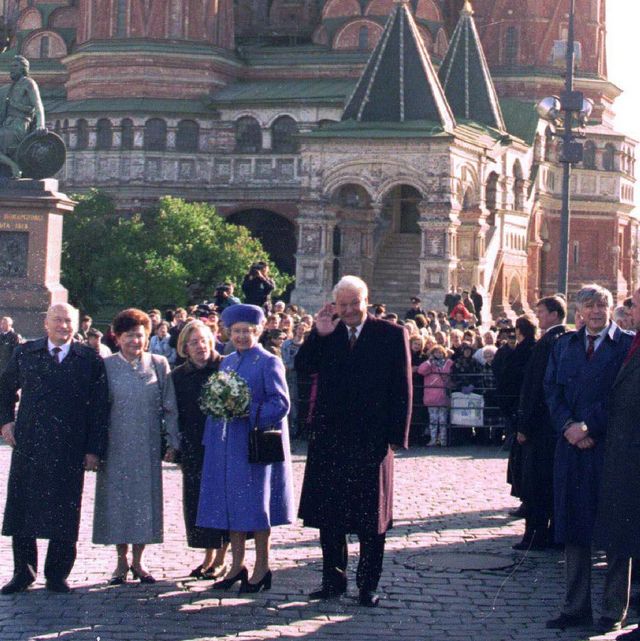
Here, see all the photos of Queen Elizabeth's 1994 trip to Russia, as shown on The Crown :
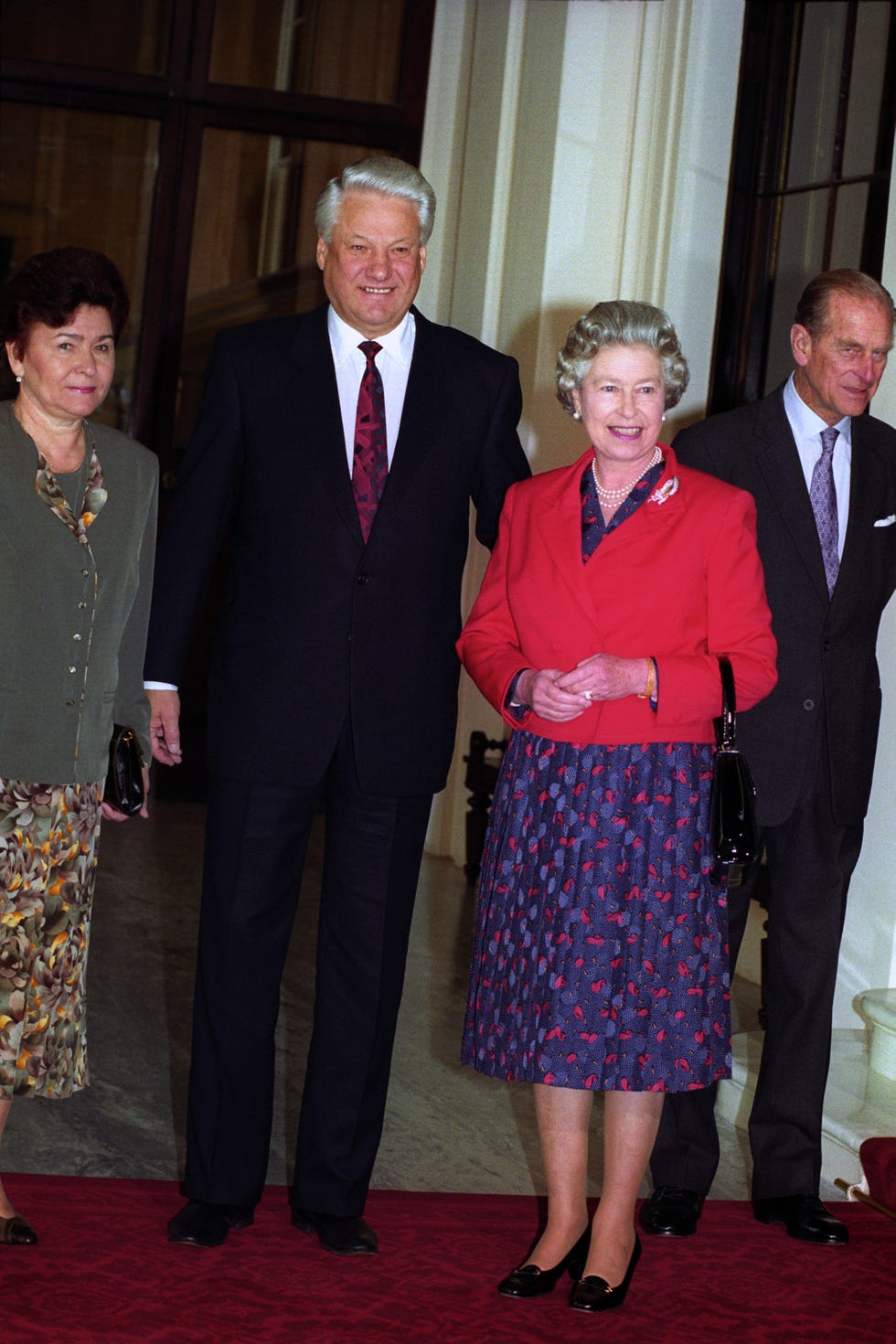
This is not from the State Visit to Russia, rather this is when Yeltsin visited the UK two years prior. Pictured are Naina Yeltsin, President Boris Yeltsin, Queen Elizabeth, and Prince Philip at Buckingham Palace.

State Visit, 1994
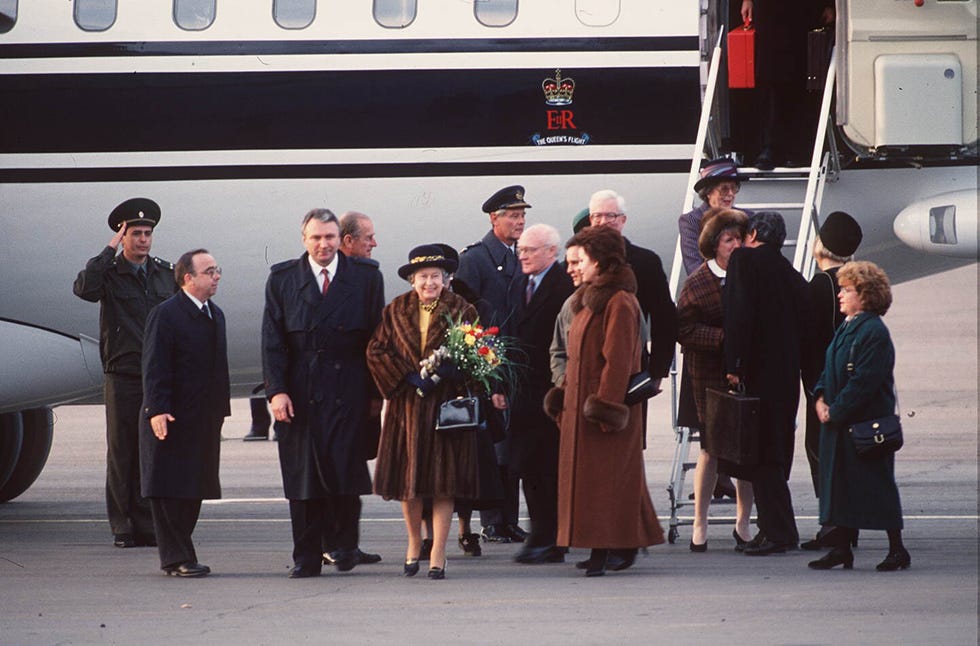
Queen Elizabeth is pictured arriving in Moscow, wearing a glamorous fur coat.
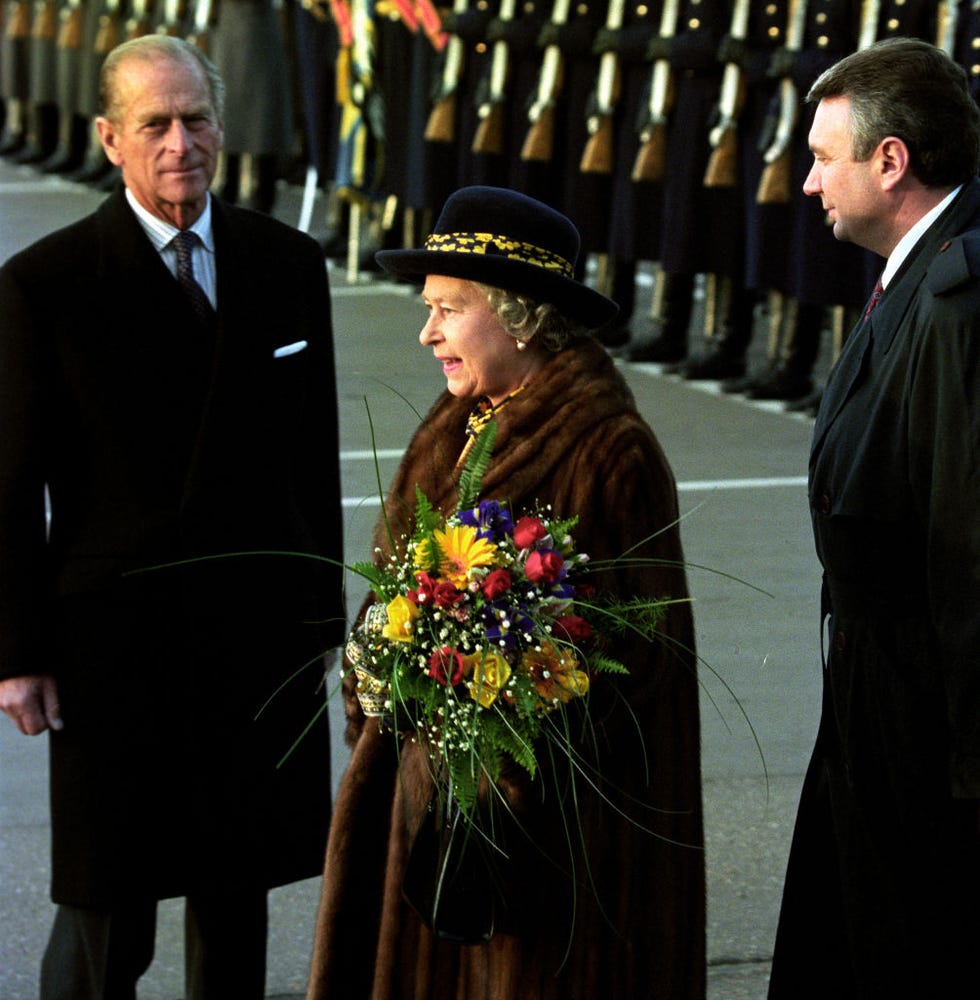
A close-up of the Queen and Prince Philip upon their arrival in Russia.
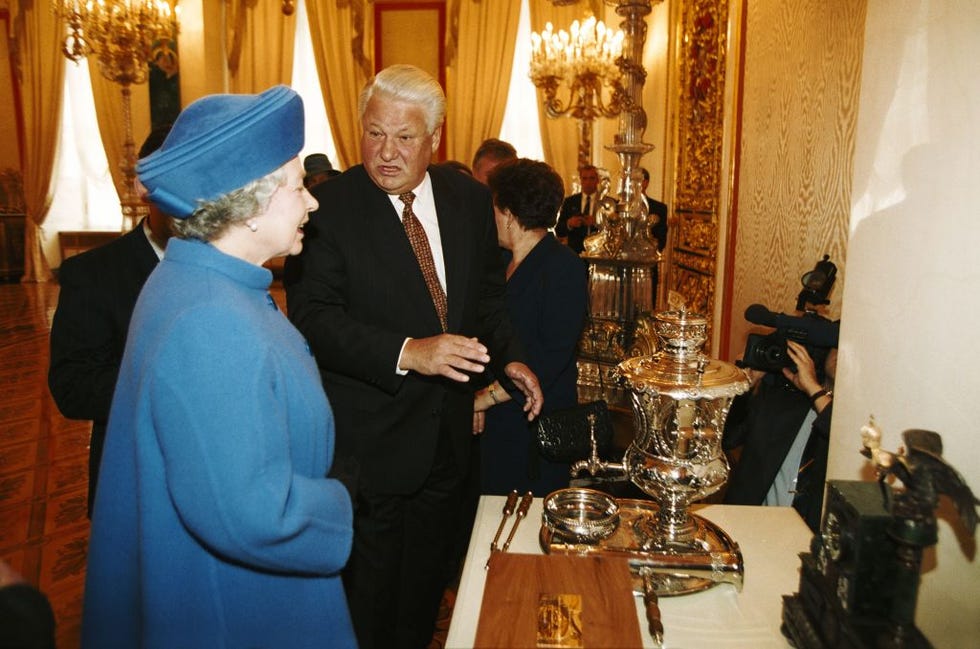
Throughout the trip, she was accompanied by Boris Yeltsin, who served as president of Russia from 1991 to 1999.
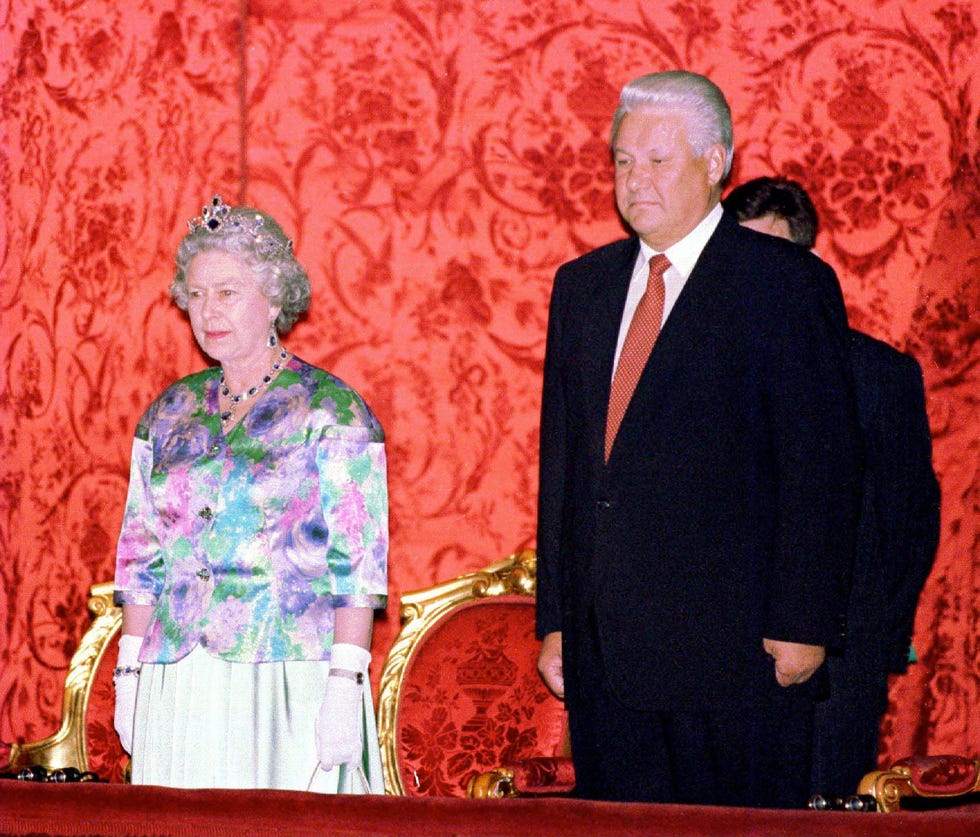
Queen Elizabeth was not the first British royal to visit Russia. In 1973, Prince Philip and Princess Anne attended a horse eventing competition in Kyiv, then part of the Soviet Union, and in 1994, Prince Charles visited Saint Petersburg.
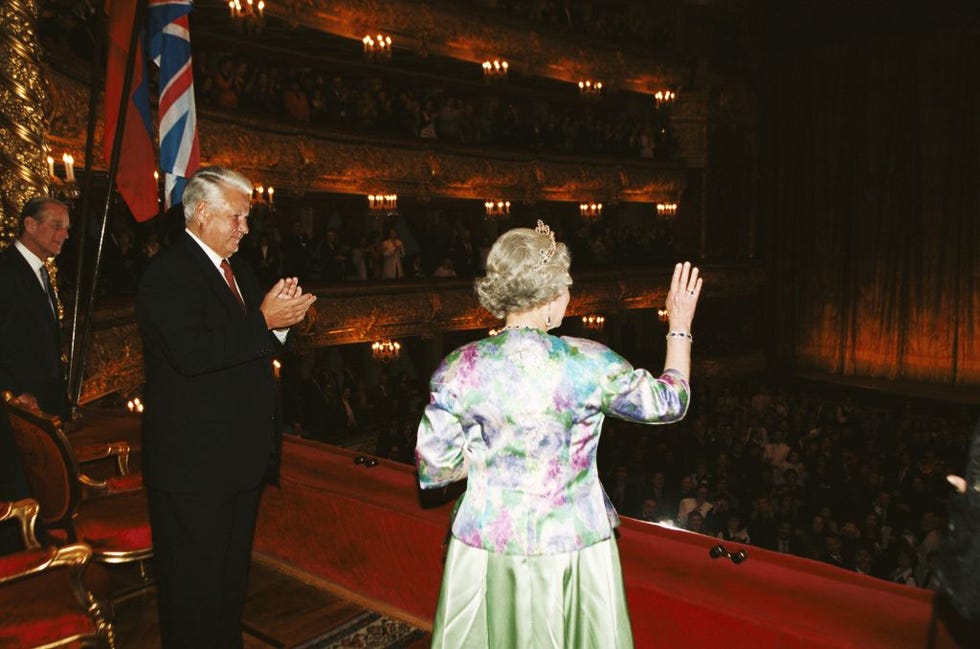
Queen Elizabeth and Prince Philip stayed in the Kremlin as guests of Yletsin.

Here, the Queen and Yetsin are pictured at the Bolshoi theatre.
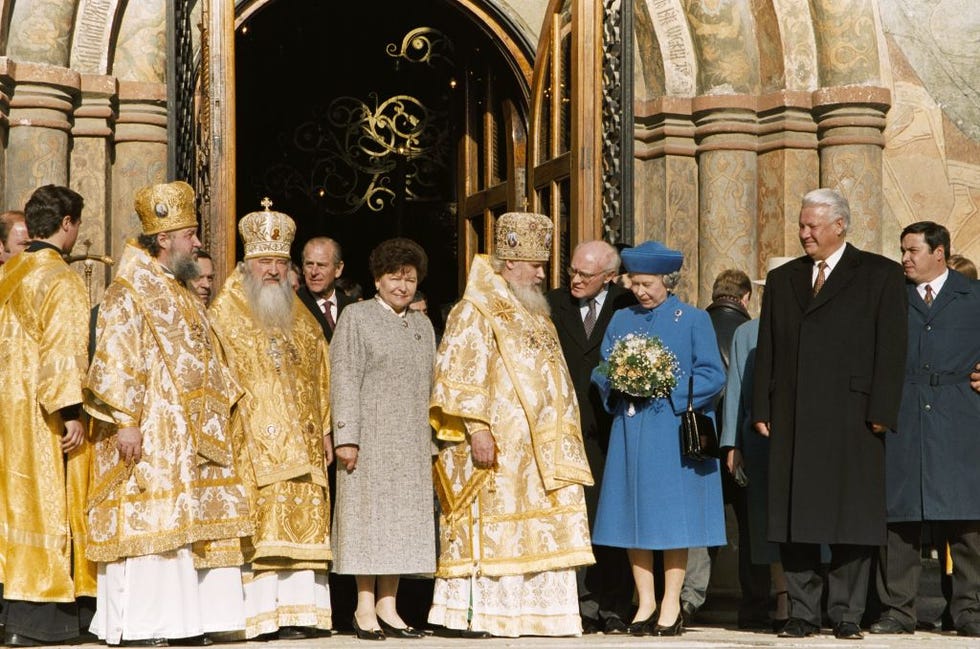
Queen Elizabeth met Patriarch Alexius II and mayor of Moscow Yury Luzhkov; they are pictured here outside Saint Basil's Cathedral.
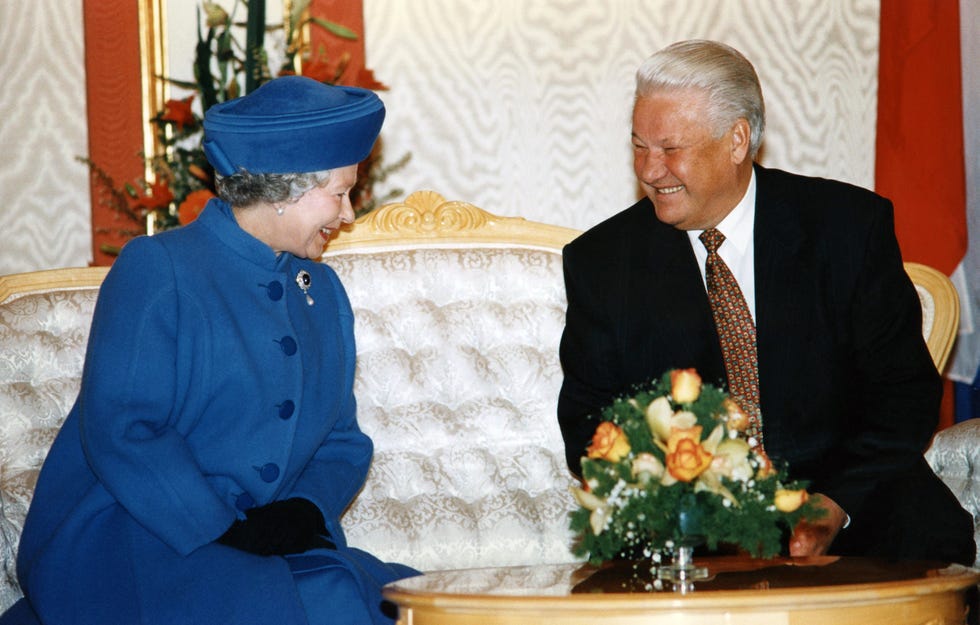
"For Russia, this visit is the utmost recognition that our country is on the road to democracy," Yeltsin told reporters of the Queen's visit.
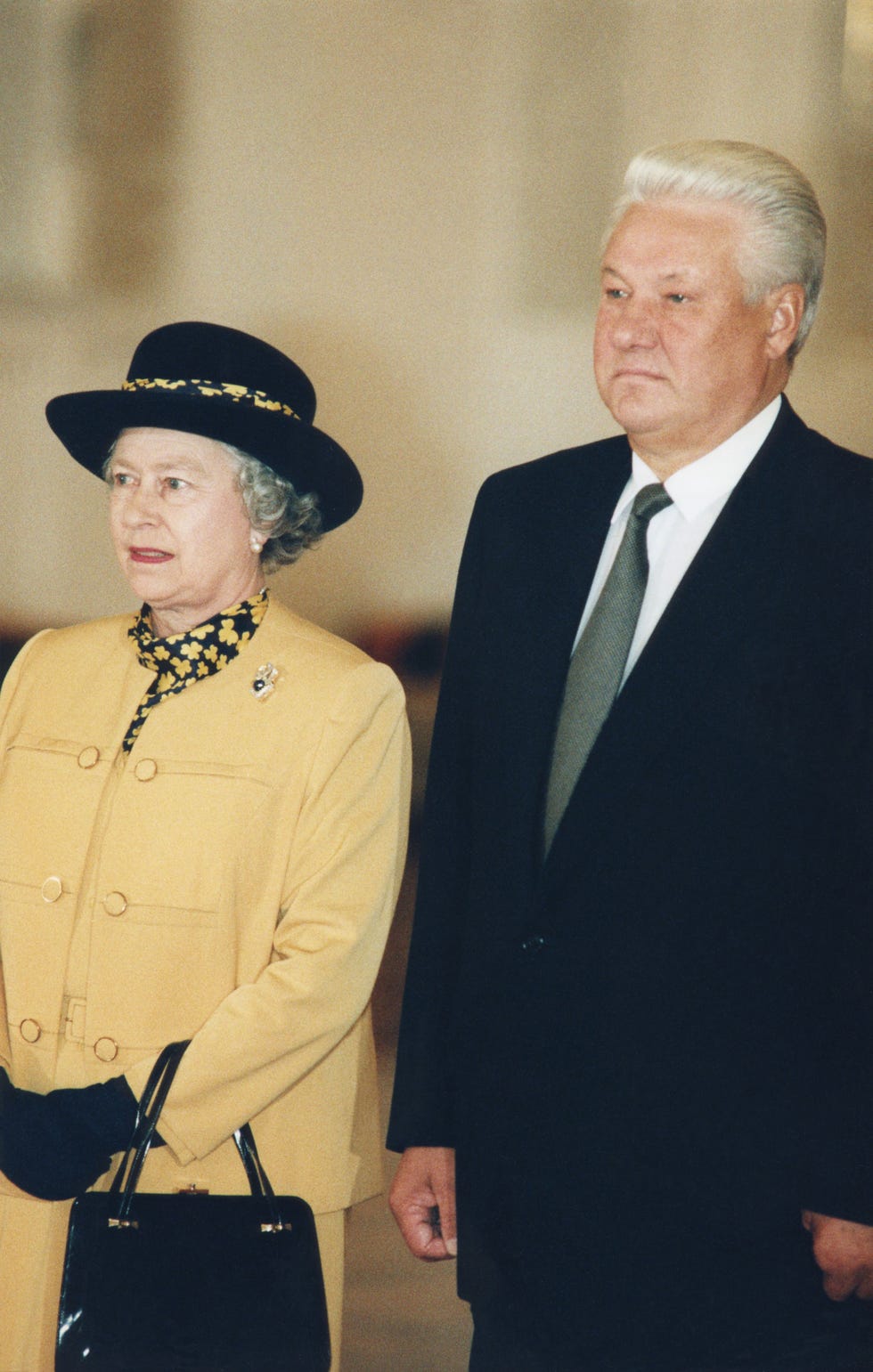
As The Crown shows, the murder of Tsar Nicholas II and his family was a reason why the Queen had yet to visit Russia. Her grandfather, King George V, was Nicholas's first cousin.
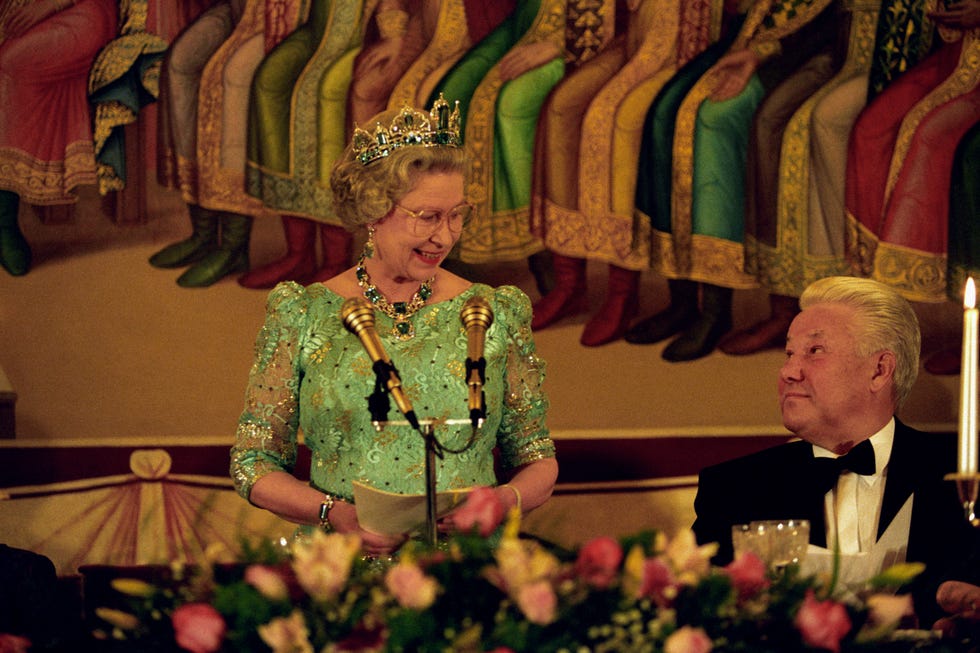
"You and I have spent most of our lives believing that this evening could never happen. I hope that you are as delighted as I am to be proved wrong," Queen Elizabeth said to Yeltsin at a state banquet.
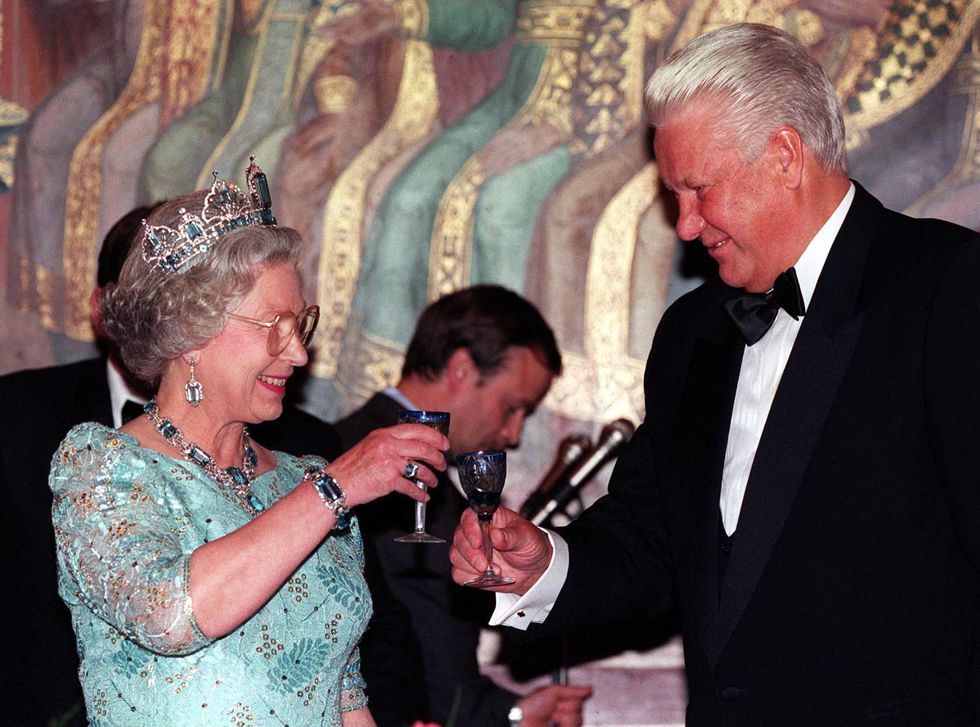
The two toasted at the banquet.
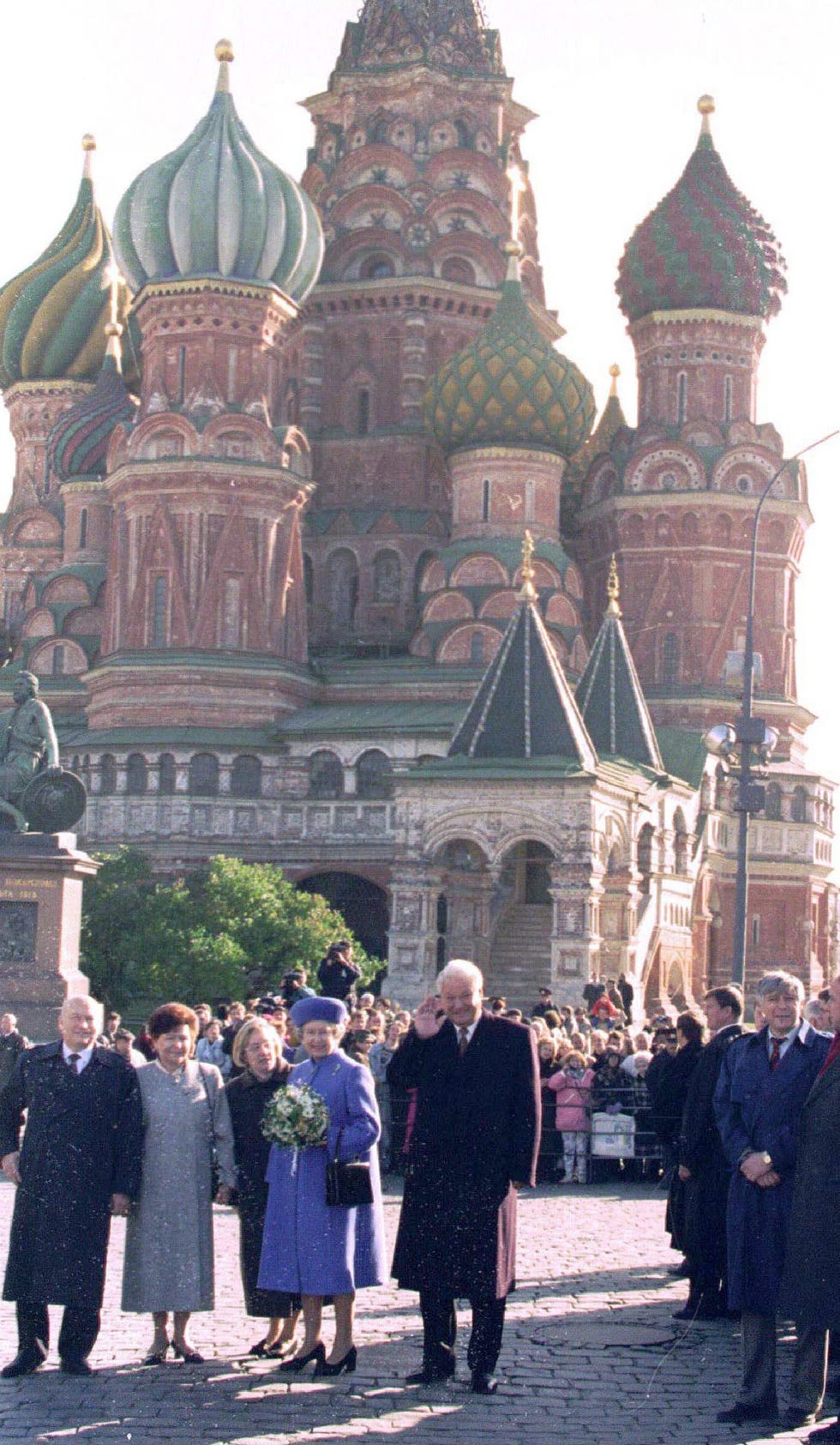
Queen Elizabeth toured Moscow during her four day trip, including visiting the famous Red Square.
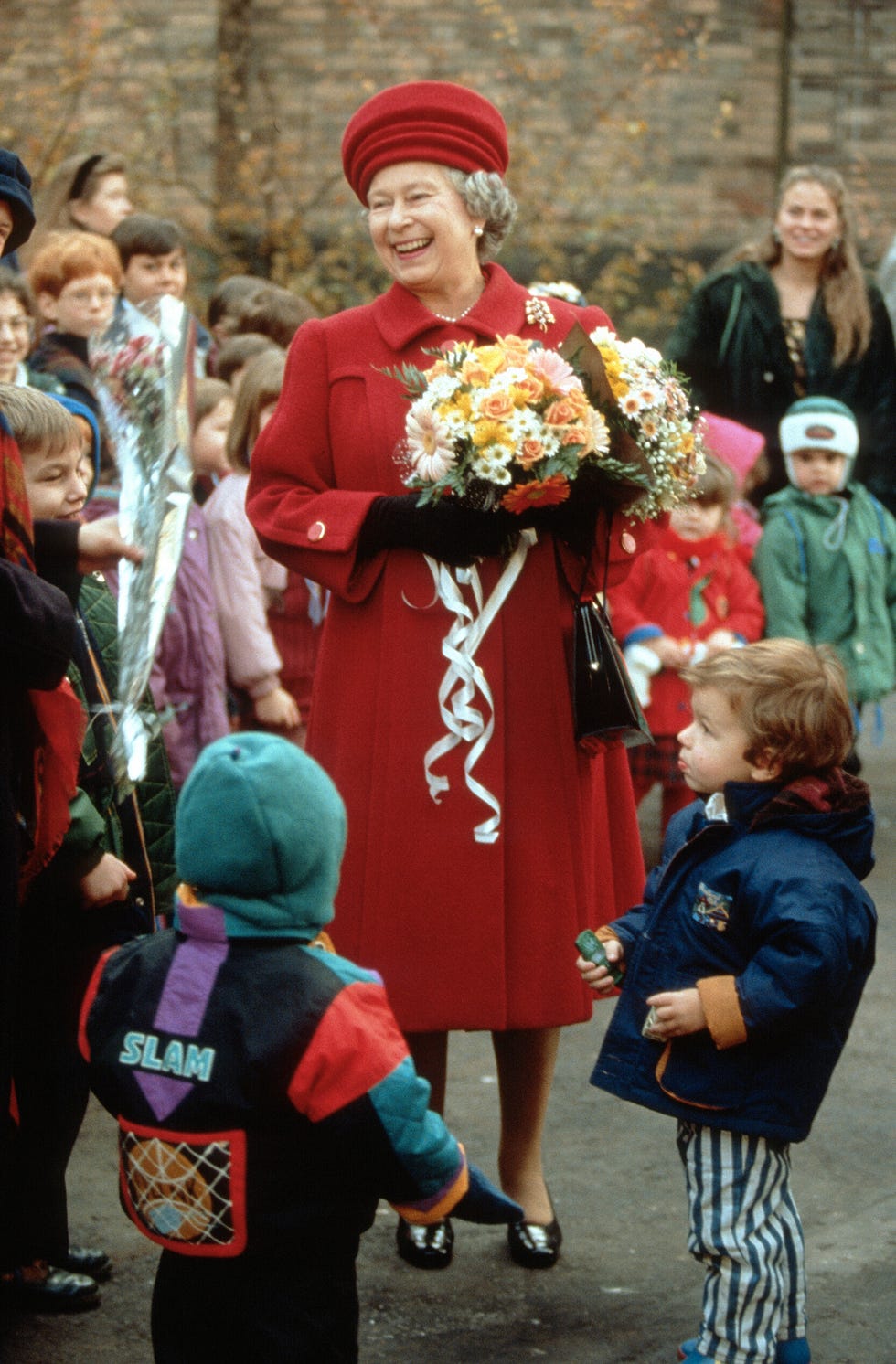
She also met Russian children.
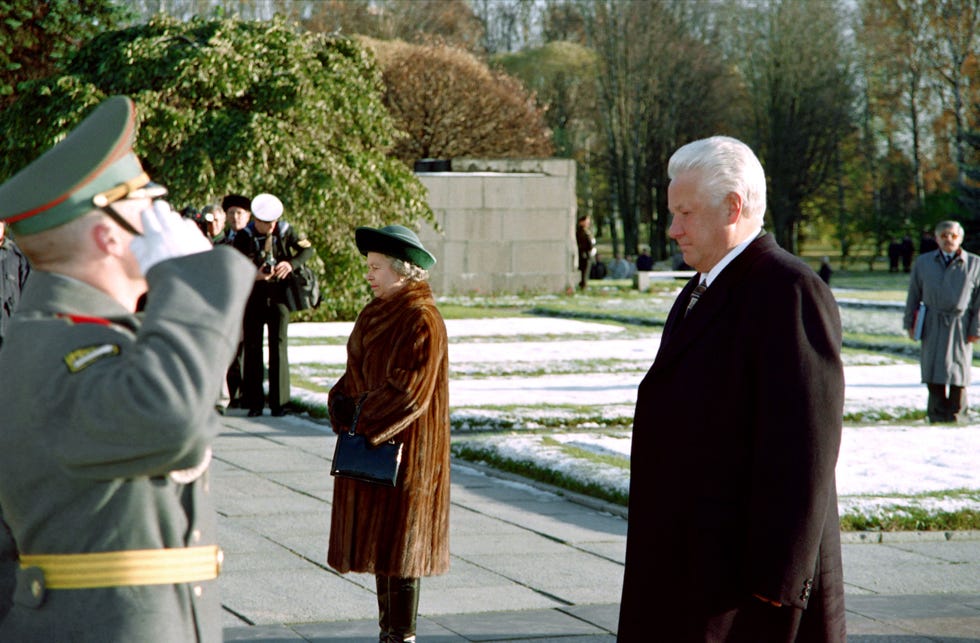
There were more formal events during the trip, too; Queen Elizabeth and Yeltsin attended a ceremony at the Piskarevskoye cemetery, a WWII memorial in St. Petersburg.
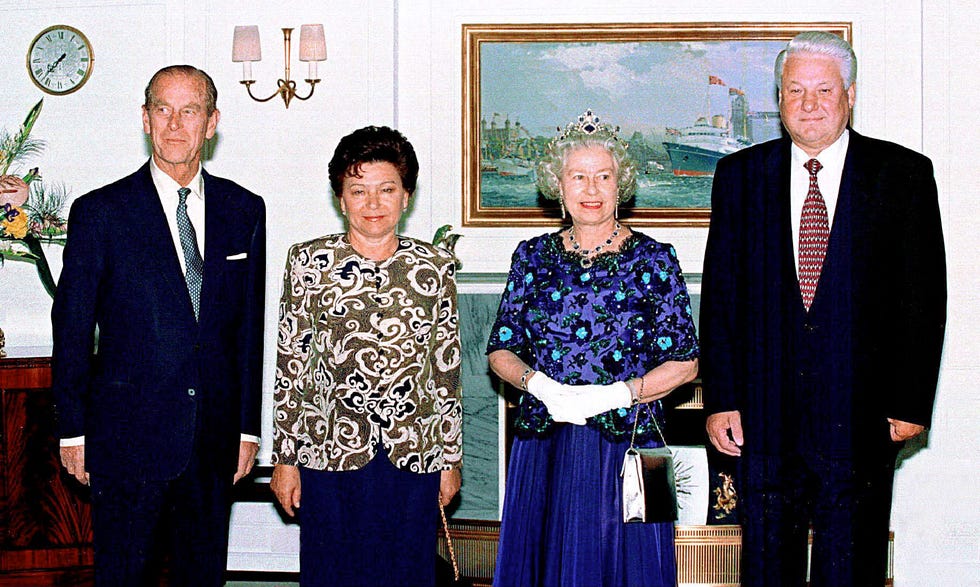
During the trip, Prince Philip and the Queen hosted the Yeltsins on board the Royal Yacht Britannia for a banquet.
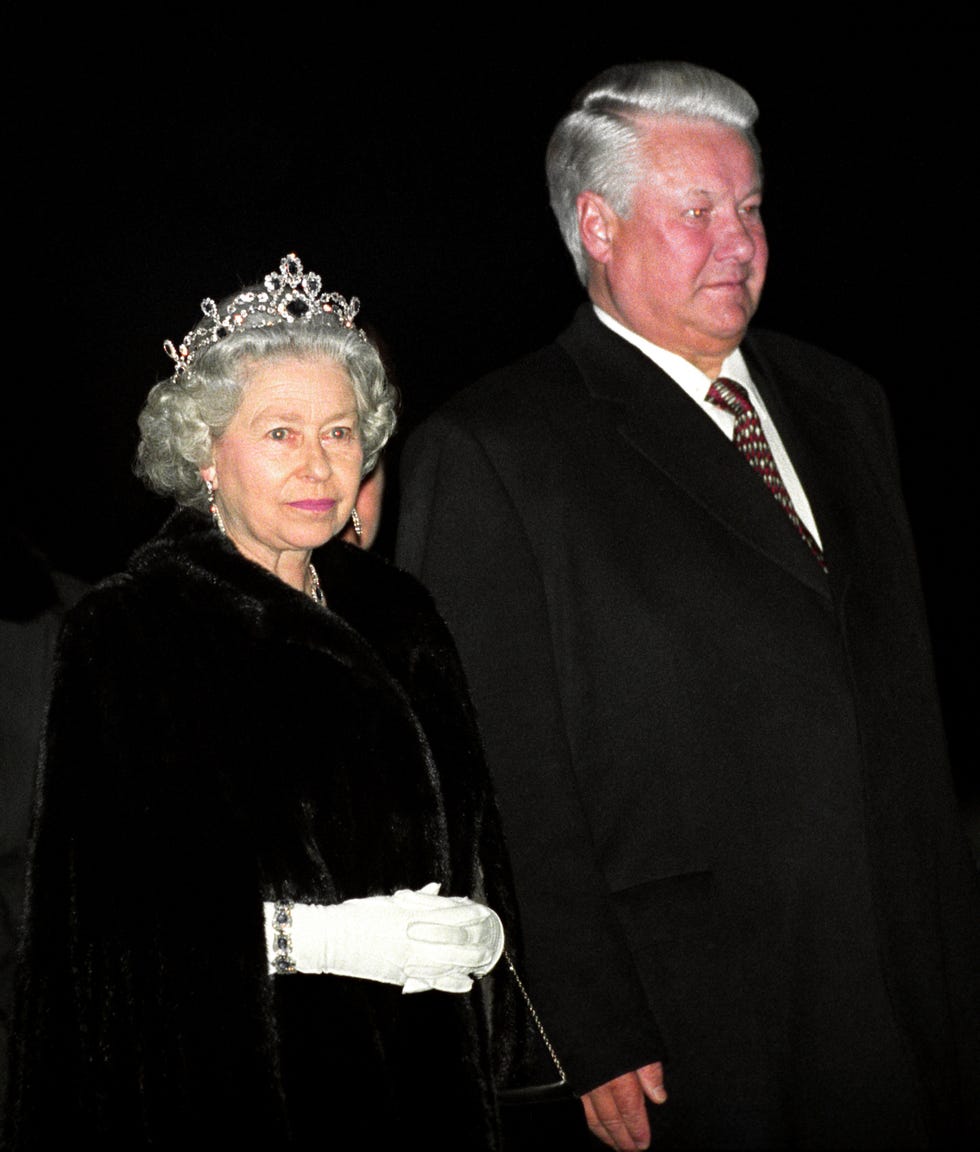
During her Christmas address two months later, Queen Elizabeth reflected, "I never thought it would be possible in my lifetime to join with the Patriarch of Moscow and his congregation in a service in that wonderful cathedral in the heart of the Moscow Kremlin."
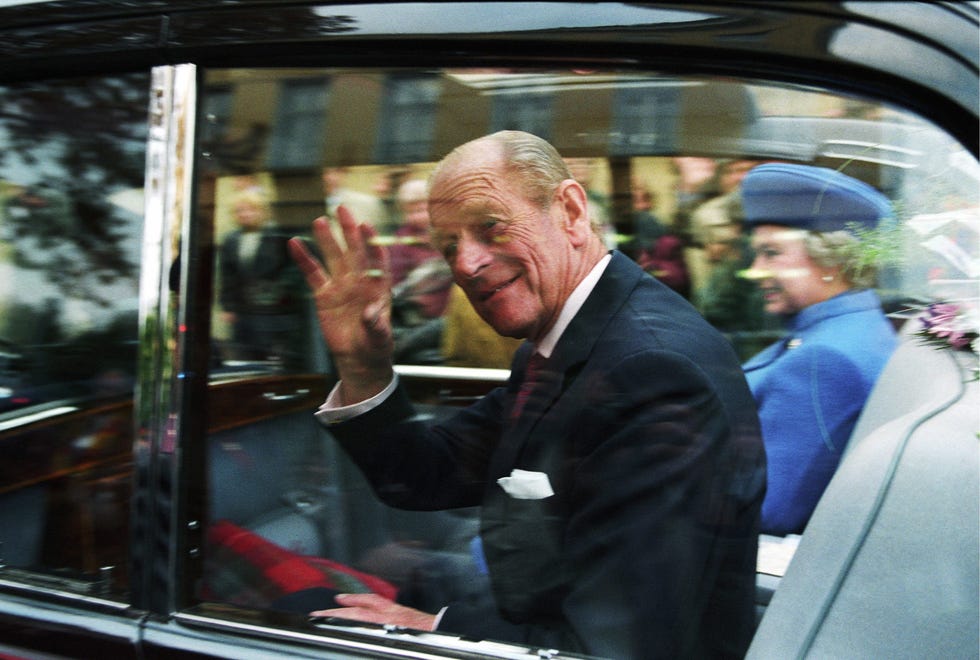
Queen Elizabeth would not return to Russia; Prince Philip returned once more, in 1995, as president of the World Wildlife Fund.
Emily Burack (she/her) is the Senior News Editor for Town & Country, where she covers entertainment, culture, the royals, and a range of other subjects. Before joining T&C, she was the deputy managing editor at Hey Alma , a Jewish culture site. Follow her @emburack on Twitter and Instagram .
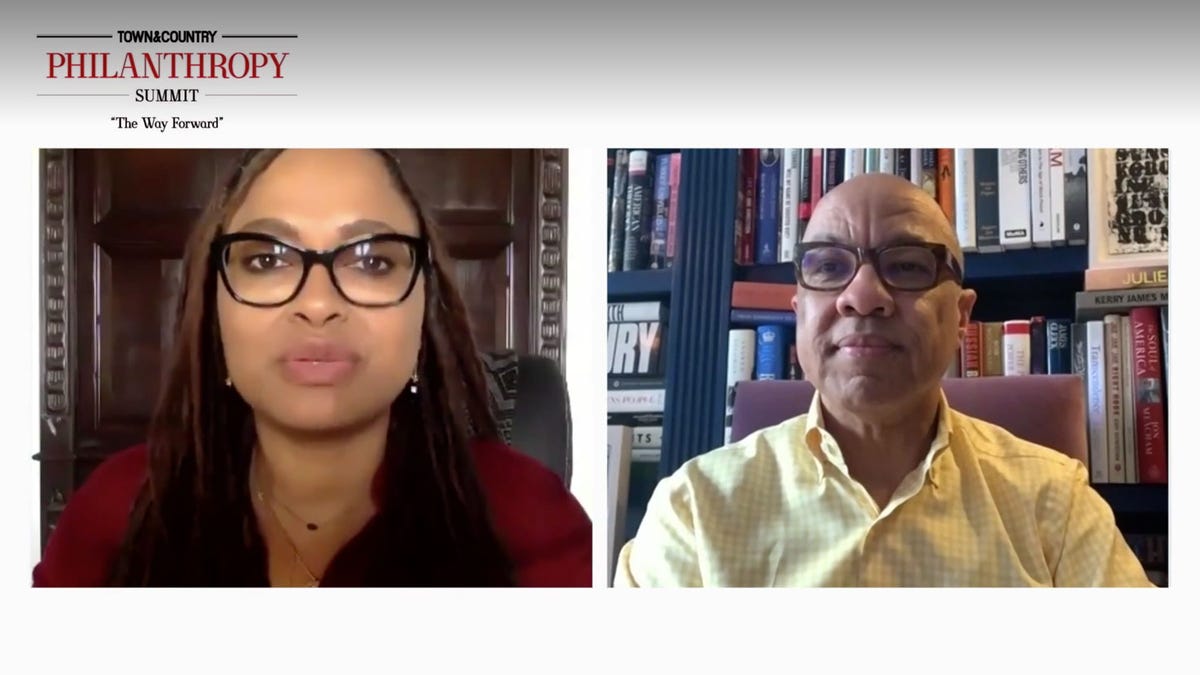
@media(min-width: 40.625rem){.css-1jdielu:before{margin:0.625rem 0.625rem 0;width:3.5rem;-webkit-filter:invert(17%) sepia(72%) saturate(710%) hue-rotate(181deg) brightness(97%) contrast(97%);filter:invert(17%) sepia(72%) saturate(710%) hue-rotate(181deg) brightness(97%) contrast(97%);height:1.5rem;content:'';display:inline-block;-webkit-transform:scale(-1, 1);-moz-transform:scale(-1, 1);-ms-transform:scale(-1, 1);transform:scale(-1, 1);background-repeat:no-repeat;}.loaded .css-1jdielu:before{background-image:url(/_assets/design-tokens/townandcountrymag/static/images/diamond-header-design-element.80fb60e.svg);}}@media(min-width: 64rem){.css-1jdielu:before{margin:0 0.625rem 0.25rem;}} The Crown @media(min-width: 40.625rem){.css-128xfoy:before{margin:0.625rem 0.625rem 0;width:3.5rem;-webkit-filter:invert(17%) sepia(72%) saturate(710%) hue-rotate(181deg) brightness(97%) contrast(97%);filter:invert(17%) sepia(72%) saturate(710%) hue-rotate(181deg) brightness(97%) contrast(97%);height:1.5rem;content:'';display:inline-block;background-repeat:no-repeat;}.loaded .css-128xfoy:before{background-image:url(/_assets/design-tokens/townandcountrymag/static/images/diamond-header-design-element.80fb60e.svg);}}@media(min-width: 64rem){.css-128xfoy:before{margin:0 0.625rem 0.25rem;}}
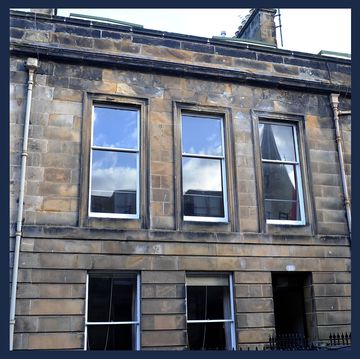
How Did Prince William and Kate Middleton Meet?
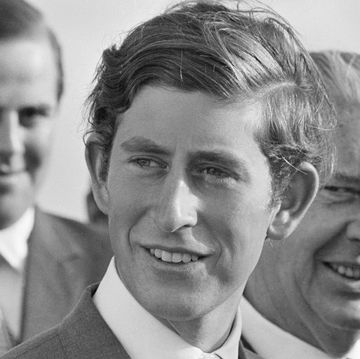
King Charles III's Life in Photos
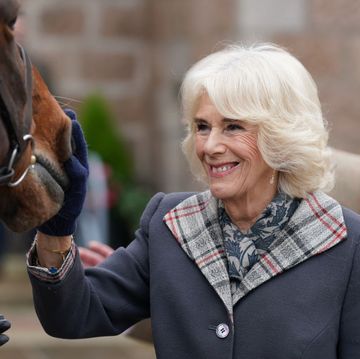
Queen Camilla's Life in Photos
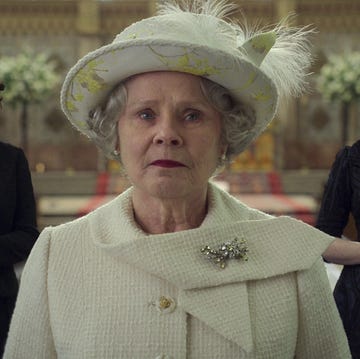
'The Crown' Leads BAFTA TV Nominations

Elizabeth Debicki Wins SAG Award
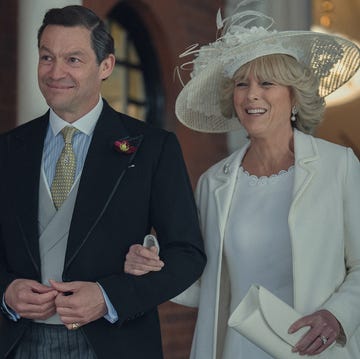
Dominic West Stayed in Bed After 'The Crown'
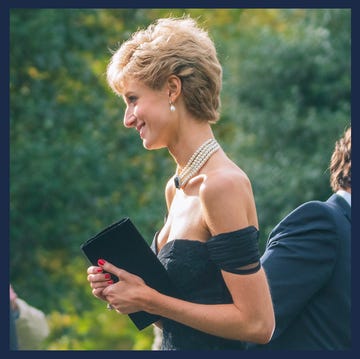
The Crown's Costumes, Props, and More at Auction

Elizabeth Debicki Stuns in Dior

Elizabeth Debicki's Best Red Carpet Looks
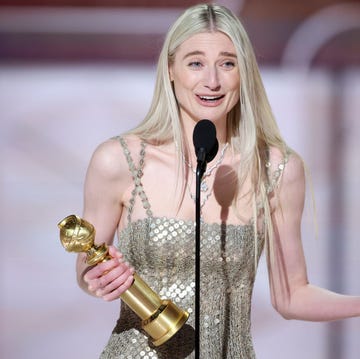
Elizabeth Debicki Wins Golden Globe

Jonathan Pryce Apologized to Princess Anne
WATCH: Queen Elizabeth was the first British monarch to visit Russia
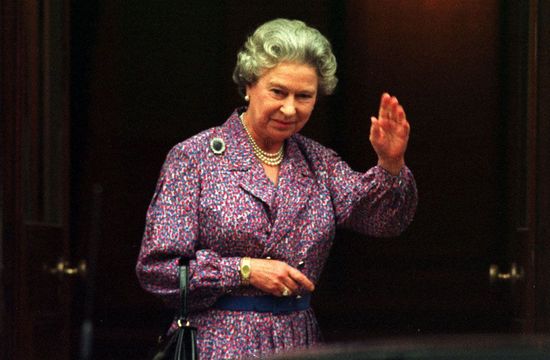
Queen Elizabeth II, photographed in 1993. RollingNews
On Oct 17, 1994, Queen Elizabeth II became the first ruling British monarch to set foot on Russian soil.
As the eyes of the world are on Russia and the invasion of Ukraine, which has caused I migration of refugees unlike anything seen since World War II, we thought it interesting to look back at the October 1994 of Queen Elizabeth II to the Kremlin, by invitation of the then Russian President Boris Yeltsin.
In 1994 the Queen made a three-day visit to Russia. Three years before had seen the dissolution of the Soviet Union, when Yeltsin took office. His hope was that Her Royal Majesty's visit would strengthen the trade relationship with Britain and the Western World.
Yeltsin's spokesman, Vyacheslav Kostikov, said at the time "We realize that the British queen would never have visited a Communist country."
- History of "God Save the King", Britain's National Anthem
Personally, 1994 was also a difficult time for the Queen personally as her son, Prince Charles, had separated from Princess Diana, just two years earlier. A biography of the Prince, by Jonathan Dimbleby, had caused a media frenzy over comments made by Charles with relation to his relationship with his mother and father, Prince Philip.
The Queen and Prince Philip landed in Moscow on Oct 17, 1994. They were then taken to the Kremlin where they were greeted by Yeltsin and his wife, Naina. The Royal pair were also treated to a special performance of the Bolshoi Ballet.
The climax of the tour was a state banquet given on the final evening by the Queen aboard the royal yacht Britannia which had sailed to St. Petersburg to meet the royal party.
They left Russia on Oct 20 and broke the journey home by visiting Finland.
Since 1994 some members of the Royal family have visited Russia, including Princess Anne. She visited in 2016 to mark the 75th anniversary of the first Arctic convoys from the United Kingdom during World War II. Prince Charles also Russia in 2003. This visit resulted in a return invitation to President Vladimir Putin to visit Britain later that year.
Check out some AP footage of the Queen having dinner at the Kremlin:
Related: Queen Elizabeth II
BHT newsletter
You may also like.
- Most Recent

Queen Victoria's coffin and the ...
A stern Queen, overcome by grief, who oversaw 63 years as the Monar...
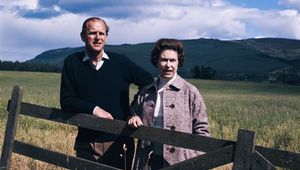
Everything you need to know abou...
Prince Philip sadly passed away on April 9, 2021. We take a look ba...

The great castles of North Wales
King Edward I’s chain of stone fortresses, across Wales is as impos...

The Irish Lord who captured Quee...
Queen Elizabeth and Patrick Plunket enjoyed a special relationship....
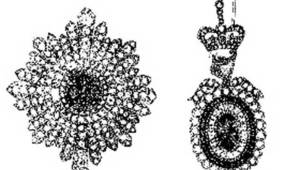
The history of the Irish Crown J...
Did you know that Ireland was presented with crown jewels by both H...

When Winston Church became Prime...
On May 10, 1940, Winston Churchill, the British leader who guided G...

Who is Prince Richard, Duke of G...
Prince Richard the Duke of Gloucester is the late Queen’s cousin an...

The most expensive jewelry the R...
The prices of some of these pieces of jewelry will surprise you!
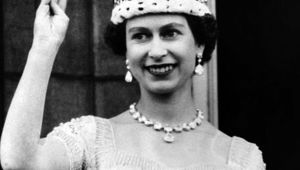
Queen Elizabeth II's Coronation:...
The Coronation of Queen Elizabeth II was ground-breaking in its own...
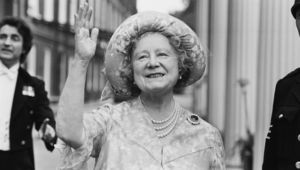
Britain’s Queen Mother was despe...
State papers reveal that Queen Elizabeth's mother was "dying to go"...
Queen Elizabeth Makes Historic Visit to Russia
- Show more sharing options
- Copy Link URL Copied!
Queen Elizabeth II, leaving behind the latest Royal Family flap, came to the Kremlin on Monday on the first visit to Russia by a British monarch.
A new authorized biography of her son and heir, Prince Charles, threatened to overshadow the visit by the queen and her husband, Prince Philip. In the book, Charles accuses Philip of forcing him into a loveless marriage.
Russian President Boris N. Yeltsin’s chief spokesman, Vyacheslav V. Kostikov, said the queen’s visit is evidence of Russia’s break with its totalitarian past.
“We realize that the British queen would never have visited a Communist country,” Kostikov said.
Both the queen and Prince Philip are related to the imperial Romanov family of Czar Nicholas II, executed by Bolshevik revolutionaries in 1918. The queen’s grandfather, King George V, the czar’s first cousin, refused to give Nicholas II asylum a year earlier.
The 68-year-old queen, wearing a fur coat and pillbox hat, was greeted at Moscow’s Vnukovo-2 airport by First Deputy Prime Minister Oleg N. Soskovets. A beaming Yeltsin and his wife, Naina, gave the royal couple a formal welcome at the ornate St. George’s Hall in the Kremlin.
The royal couple are staying in the Kremlin as Yeltsin’s guests. They attended a performance of “Giselle” at the Bolshoi Ballet on Monday evening, sitting in the “czar’s box” under the coat of arms of the former Soviet Union.
Back in Britain, newspapers were full of speculation about excerpts from the biography of Charles.
Charles recalls how, as a boy, his mother paid him little attention and his father belittled him to the point of tears. As an adult, Charles suggests that Philip pressured him into marrying Princess Diana, whom he says he never loved.
More to Read
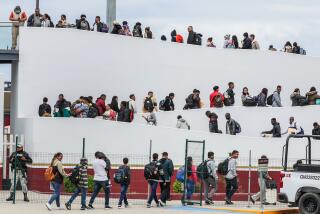
Migrants play ‘the asylum lottery’ on controversial U.S. government app
May 9, 2024

Hidden panels, counterfeit bottles, fentanyl: A year of buying drugs in Mexican pharmacies
Dec. 30, 2023

Russia puts Ukrainian President Zelensky on its wanted list
May 4, 2024
Start your day right
Sign up for Essential California for news, features and recommendations from the L.A. Times and beyond in your inbox six days a week.
You may occasionally receive promotional content from the Los Angeles Times.
More From the Los Angeles Times
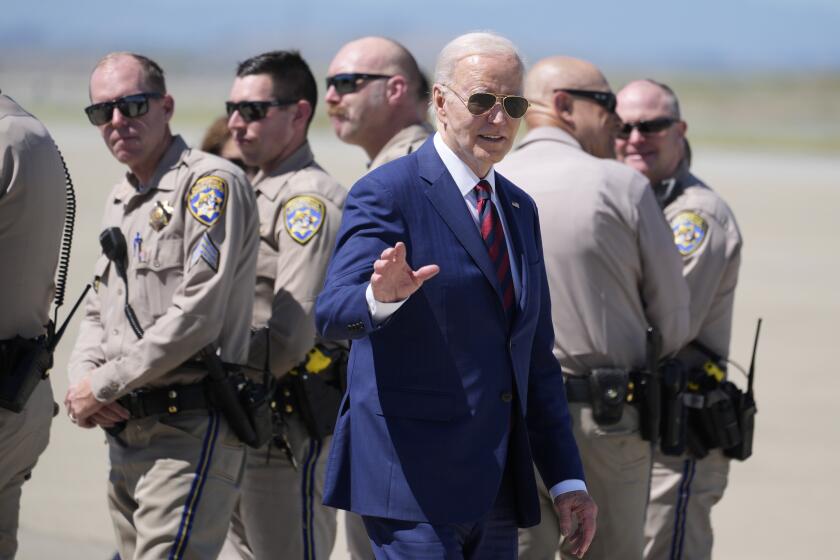
Biden raises millions in the Bay Area as he says his campaign is underestimated
May 10, 2024
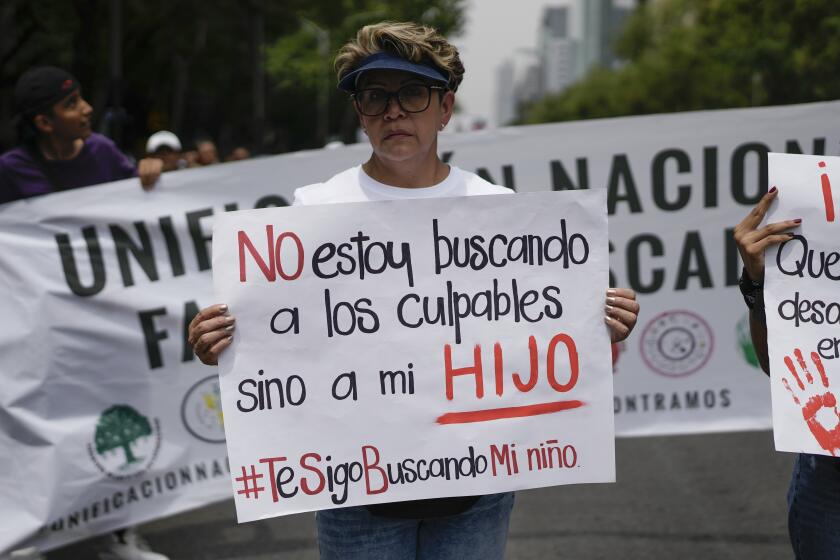
World & Nation
Mother’s Day is a sad reminder for the mothers of Mexico’s over 100,000 missing people
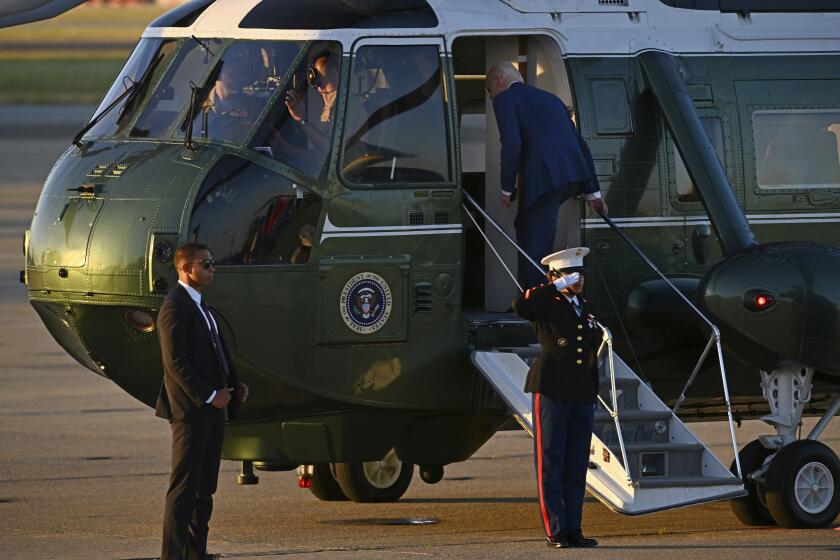
U.S. says Israel’s use of American arms likely violated international law, but evidence is incomplete
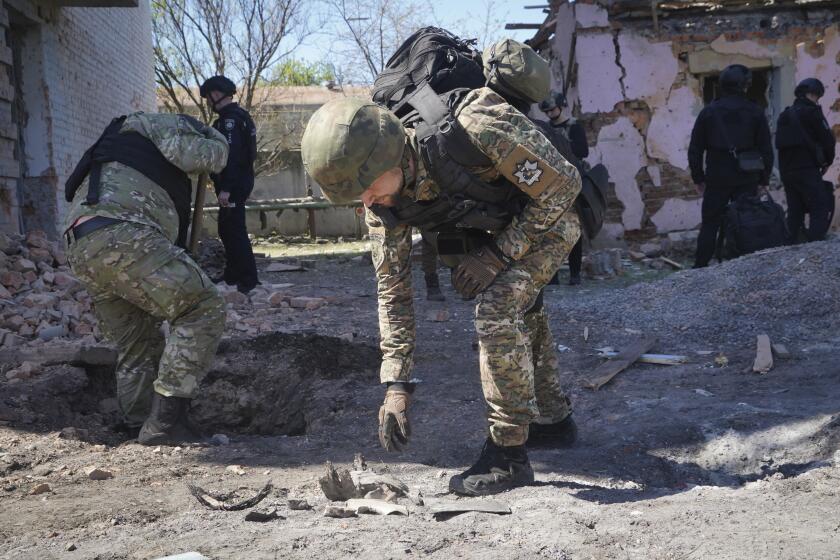
Russia tries to breach Ukraine’s defenses in the Kharkiv region. Feint, or all-out assault?
- Australia edition
- Europe edition
- International edition

How Yeltsin helped thaw the big freeze with Britain
Boris Yeltsin's visits to Britain and Ireland mixed high politics with low farce. The low point surely came on September 30 1994, when the then Irish prime minister Albert Reynolds, was left standing on the runway at Shannon airport studying his wristwatch as Mr Yeltsin conspicuously failed to emerge from his plane.
There was prolonged confusion and mounting embarrassment as Mr Reynolds, anxious to brief Mr Yeltsin on the developing Northern Ireland peace process, waited on the tarmac for 15 minutes. But Mr Yeltsin, on a stop-off during a flight home to Moscow after talks with the US president, Bill Clinton, failed to leave his Ilyushin 62 jet.
An Irish army battalion due to provide Mr Yeltsin with a guard of honour and a military band waiting to play the national anthems were stood down after it became clear the Russian president was not going to appear.
A puzzled Mr Reynolds had 30 minutes of talks with Russian deputy prime minister, Oleg Soskovetz, who later reported that his leader had been "too tired after a 17-hour flight" across the Atlantic to see his Irish host. When he arrived back in Moscow, Mr Yeltsin told reporters: "I can tell you honestly, I just overslept."
Although Mr Reynolds denied feeling snubbed, commentators universally assumed that the vodka-loving Russian president's non-appearance had been the result of heavy drinking rather than illness or tiredness.
Mr Yeltsin's fondness for drink was indulged by the British prime minister John Major in September 1994 when, during a weekend of informal talks at Chequers, Mr Major and his wife, Norma, took Mr Yeltsin and his wife, Naina, for a quick drink at the local pub, the Bernard Arms.
That the Russian president was less than permanently absorbed by the intricacies of high-level diplomacy was also evident in May 1998, when while attending the G8 summit in Birmingham he collected a set of talking Teletubby toys to take back to Moscow for his grandchildren.
But such incidents aside, his dealings with Britain did cover issues of great moment. He also grasped opportunities to defrost the Anglo-Russian relationship the cold war had put into the freezer. On January 30 1992, while making his first visit to Britain since becoming Russian president, Mr Yeltsin announced that Russian missiles would henceforth be turned away from British targets.
After four hours of talks with John Major, the two leaders agreed a 15-point declaration committing them to peaceful settlement of disputes, control of weapons of mass destruction and nuclear non-proliferation. On November 9 1992, after another set of talks at Downing Street, Mr Major and Mr Yeltsin signed a series of agreements, including the first friendship treaty between their two countries since 1766. The move prompted Mr Major to declare: "We are consigning the cold war to history."
Later the same day, Mr Yeltsin made a symbolic visit to the heart of capitalism, London's stock exchange. The next day, he enjoyed the rare honour of being invited to address a joint session of both houses of parliament. Lunching with the Queen at Buckingham Palace, he invited her to visit Russia. And in October 1994, the thaw in the relationship between Britain and Russia was completed when the Queen finally accepted the invitation.
The visit to Moscow put an end to more than seven decades of estrangement between the Kremlin and Europe's royalty over the murder in 1918 of Tsar Nicholas II and his wife and children, who were relatives of the British royal family. Becoming the first British monarch to set foot in Russia since 1908, the Queen, accompanied by the Duke of Edinburgh, received the warmest of welcomes from her host. Mr Yeltsin pulled out all the stops, treating his visitors to a glittering reception at the Kremlin and a visit to the Bolshoi ballet.
In October 1997, the good relations between Britain and Russia were cemented further when Tony Blair visited Moscow. The Russian leader bear-hugged Mr Blair, describing him as "young, energetic, very vigorous and thrusting". Mr Blair in turn complimented Yeltsin on being one of the most "dynamic and capable" leaders in the world.
Most viewed
clock This article was published more than 29 years ago
ELIZABETH II VISITS RUSSIA ON WAVE OF ROYAL GOSSIP
MOSCOW, OCT. 17 -- Britain's Queen Elizabeth II arrived in Russia today for a visit that draws a symbolic close to seven decades of royal frostiness toward Russia over the assassination of Czar Nicholas II, the queen's distant cousin, whose execution with his family by Bolshevik revolutionaries in 1918 ended the monarchy here.
The royal visit, which British officials consider one of the queen's most important foreign trips, was overshadowed before it began by a furor in England over a new biography of Prince Charles, the queen's son and heir.
Aides traveling with the queen spent much of today playing down the controversy caused by the book, in which Charles says he never loved his wife and suffered from a lack of affection and a domineering father.
Russians, however, seemed less interested in the newest palace dust-up than in the glamor of having royalty here again. Newspaper and television coverage of the first visit by a British monarch began several days ago and continued at a fast pace today, with particular focus on the glitter and the generally warm feelings most Britons have toward the queen.
Russia is in the midst of a mini-monarchist boom, with some polls showing that as many as 18 percent of Russians favor a return to monarchy. A monarchist party was established recently, and a teenage descendant of Nicholas II who lives in Europe and is said to be an heir to the Romanov throne has been treated with growing respect here, even in official circles.
Whether Elizabeth will say anything publicly during about the last czar is unclear, but she will visit the church in St. Petersburg where czars are buried. This spring, the bones of Nicholas II, recently uncovered from a pit near Yekaterinburg where his Bolshevik killers tossed them in 1918, are to be interred there as well.
Elizabeth's grandfather, King George V, and Nicholas were first cousins and looked like identical twins. Although the two monarchs were friendly, the British government refused Nicholas political asylum after he was overthrown in 1917, apparently because George feared a surge of anti-monarchist sentiment in England. Nicholas and his family were shot several months later.
Lingering hostility over the fate of Nicholas had prevented a royal trip until now, despite an invitation by the last Soviet leader, Mikhail Gorbachev. But the dramatic political and economic changes of the past few years apparently changed minds in London, and Buckingham Palace responded positively to an invitation by President Boris Yeltsin, who ended communist rule here in 1991. Other members of the royal family have already visited Russia -- including Charles and Prince Philip, the queen's consort and Charles's father.
Today, Yeltsin told reporters: "For Russia, this visit is the utmost recognition that our country is on the road to democracy."
In an interview published today in the Daily Telegraph newspaper, Prince Philip -- whose own kinship to the last czar devolves through Greek royalty -- said the grisly death of the Romanovs was part of his family history. "But I don't look at this as a family occasion," he said. "We went through this whole drama of the collapse of the Marxist state, and now we see the gradual recombining of countries... . There is tremendous potential."
British officials said the queen's four-day visit is not intended to focus on old wounds but is designed to acquaint the 68-year-old queen with today's Russia. Her schedule here and in St. Petersburg is full of ceremonial events at the Kremlin, where she and Prince Philip are staying; cultural forays around town; and meetings with Russians of all stripes.

- Russian London
- Miscellaneous
- Suggest an event to Afisha.London

Elizabeth II and Russia: a visit to Moscow, a box for Yeltsin and the impressions of eyewitnesses
On September 8, 2022, Queen Elizabeth II of Great Britain passed away, and the whole world mourns the loss. Over the 70 years of her reign, she became a mother of 4 children, a grandmother for 20 grandchildren and great-grandchildren, and an idol for millions. In Russia, the Queen is respected, her only visit to Russia and the legendary dinner with Gagarin are remembered. Afisha.London magazine traced the connections of the royal house with Russia and took comments from those who were lucky enough to meet Elizabeth in Moscow.
Romanovs and Windsors
Britain and Russia. Perhaps it would sound surprising that such distant countries have more in common than it seems at first glance. There is an inseparable connection between the Romanov dynasty and Queen Elizabeth, along several lines. First of all, the Queen’s husband, Prince Philip, was the great-grandson of Nicholas I. His grandmother Olga Konstantinovna Romanova married the King of Greece Andrei of Greece and Denmark.
The queen herself also has family ties with the Romanovs. Elizabeth’s grandfather, George V, was a cousin of Nicholas II. Contemporaries of the emperor and king noted: brothers were incredibly similar. That is why the queen and the prince experienced conflicting, but undoubtedly warm feelings towards Russia.

Elizabeth’s great-great-grandmother, Queen Victoria, also had close ties to Russia. Around 1836–1838, Crown Prince Alexander II went on a trip to Europe. His father, Nicholas I, armed the young Tsarevich with a list of worthy brides, among whom Alexander should have chosen a wife. The list included European aristocrats, princesses and nobles, but the princess of England was not on it. Despite this, the prince went to London to meet the young Victoria. After the first visit, the girl noted the manners and stateliness of the Russian guest, and Alexander — the charm, sense of humour and youth of the interlocutor.
The close circle of the royal people knew about the interest of the prince and princess in each other, but the romance could not go beyond a short passion — for Britain and Russia, this union was unprofitable and even dangerous. In the event of a marriage, one of the parties would have to give in: either Alexander should leave his homeland and became a king consort under Victoria, or Victoria would go to mysterious Russia.
Perhaps it was these close ties that were the reason why Queen Elizabeth and Prince Philip had conflicting, but undoubtedly warm feelings towards Russia.
Follow us on Twitter for news about Russian life and culture
Russia and the Queen
Once the communist regime collapsed, it was only a matter of time before a full resumption of relations with the royal family was possible. The Queen’s first and only visit to Russia took place in 1994. Then President Yeltsin led the country.
Interesting fact: Elizabeth II became the first reigning monarch to set foot on Russian lands. As early as the 16th century, there were attempts to establish direct contact between the monarchs of Russia and Great Britain: Ivan the Terrible offered Elizabeth I to tie the countries by the bonds of their own marriage. As we know from history, the attempt failed. In total, eleven messages of the Russian Tsar to the British Queen are known.
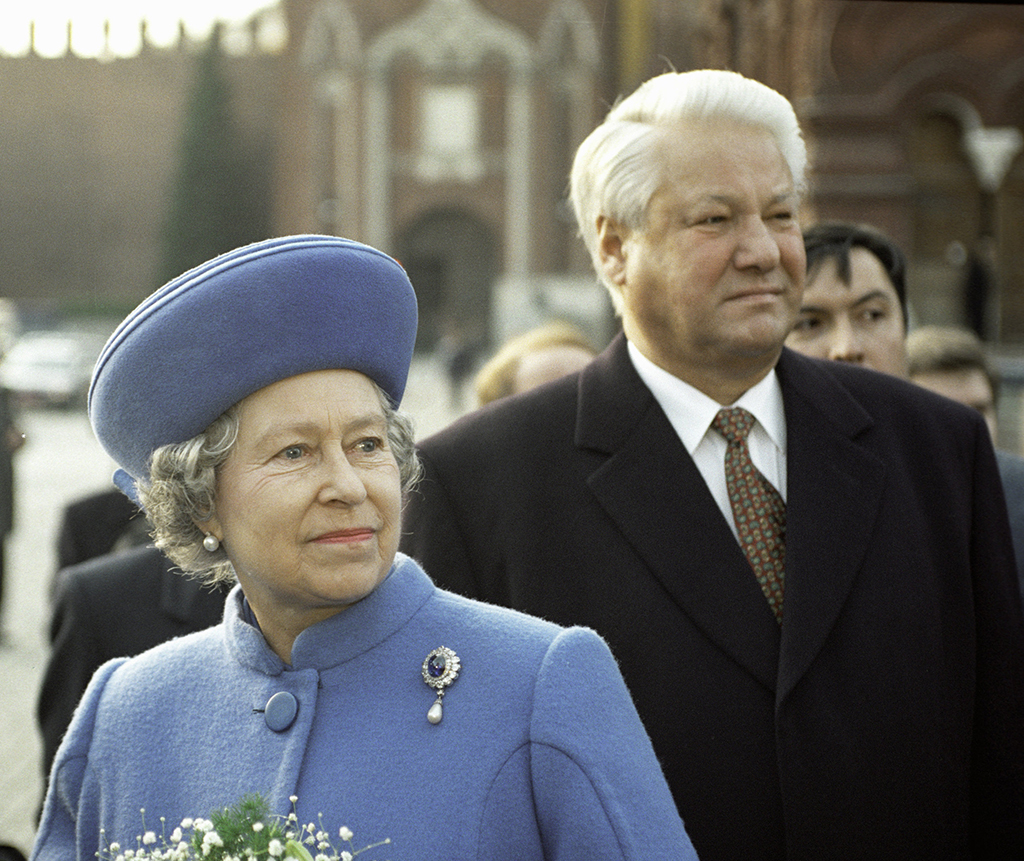
Russian President Boris Yeltsin and Queen Elizabeth II on Red Square, 1994. Photo: Dmitry Donskoy/Sputnik
The person it took most effort and time to agree to the trip was Prince Philip. He was directly related to the Russian Imperial House, and he even commented on this to reporters from the Daily Telegraph. The prince noted that the lessons of history remain in memory, but he hopes for the reunification of countries.
The preparations for the royal visit have put the Kremlin on its toes. Safety, dress code, etiquette, and even the color of the flowers presented to the queen — everything had to be right.
The meeting was remembered by the whole world: Yeltsin came very close to violating the royal protocol, almost touching the monarch in an attempt to help take off her coat, but the Queen famously dodged and there was no embarrassment. A small oversight did not prevent Elizabeth II from visiting St. Petersburg and presenting Yeltsin with a touching gift — a box with seeds from the royal garden.
The monarch managed to visit Tsarskoye Selo, the Assumption Cathedral, the Hermitage, the Mariinsky and Yusupov Palaces; meet with Patriarch Alexy II; enjoy a performance at the Bolshoi Theater and participate in the opening of the museum on Varvarka. In total, Elizabeth stayed in Russia for 4 days, during which she managed to fall in love with millions of Russians.
Incidentally, the sapphire brooch that the Queen chose for her first meeting with President Yeltsin used to be part of the decoration of the Russian Empress Maria Feodorovna, the sister of Alexandra of Denmark, who is the great-grandmother of Elizabeth II.
The most touching moment of a visit to Russia is a visit to school No. 1239 in Moscow. The children greeted the Queen with posters “Welcome, Your Majesty”, treated her to a traditional loaf of bread, junior classes performed an English-language miniature and senior kids presented a theatre performance. Queen Elizabeth II was accompanied by Moscow Mayor Luzhkov and Prince Philip. The Queen left Russia in style: on the royal yacht Britannia, which was moored to the shore of the Promenade des Anglais in St. Petersburg.
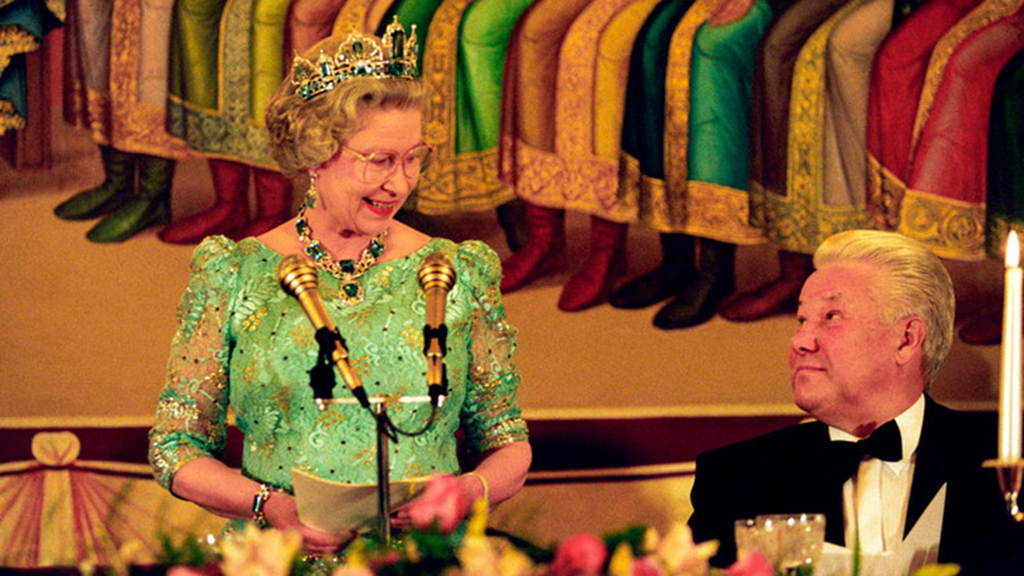
State Banquet of Queens Elizabeth II and Boris Yeltsin, Moscow, 1994. Photo: Getty Images
Bouquet for queens
To meet the Queen in person is an experience that will be remembered for a lifetime. Afisha.London reader Zhanna Macmillen was lucky enough to witness the Queen’s visit to Moscow and even be the reluctant hero of the reports of those years:
“My English husband and all the children of British subjects who wished were invited to the Anglican Church in Moscow in the morning to greet the Queen. At first, the Queen signed books — this was the formal part. Then everyone was asked to line up on the street. I was with my son Mitya, he was almost 3 years old, he was absolutely obsessed with cars. Even then, he had 3 toy cars in his hands.
I had a bouquet, and I persuaded Mitya to give it to the queen. Elizabeth approached us and instead of a bouquet, he gives her a car and only then holds out the bouquet, but begins to pull it towards him. It was, of course, a spectacle. I, like a mother, was ready to fall through the ground. But what do I do? The queen says gracefully, ‘Okay.’ And goes further. Of course, the paparazzi captured it all. The next day, all the media published this report.
At that moment I was not very cheerful, but the Queen herself reacted to this with a great sense of humour, easily and playfully. My son, of course, imagined that the Queen would look like a hero of a fairy tale by the Brothers Grimm, but here it was just a woman in a red coat and a red hat. And anyway, please let me drive her Rolls-Royce. That same evening we, as British subjects, were invited to the Bolshoi Theatre. For a reason that is not clear to me, President Yeltsin chose not the Russian ballet, not Tchaikovsky, but Giselle as the performance. The Queen watched closely, although she is not a big fan of the theatre. This is known to everyone. President Yeltsin dozed a little next to her. I think she enjoyed her evening.
I have many newspaper clippings from that time. They wrote: “The Queen’s visit to Moscow went off without a hitch, with the exception of a duel between the 3-year-old son of a British businessman and a Russian mother.” The press added colour.
I learned of the Queen’s death on Thursday evening. I got off the subway and saw my husband’s message. I had one thought: this is a very worthy life, this is a very worthy leave.
There are many queens and kings in the world. But I am sure that in every corner of the world, when they say QUEEN, everyone thinks of one — Elizabeth II. She was an absolutely incredible woman who left a good memory around the world. And we are all grateful that we lived with her. It so happened that I did manage to become her subject.
Yesterday I went to Buckingham Palace. It is incredibly touching to read the notes of people from different countries of the world. I plan to go again because there were a lot of people yesterday. I want to say goodbye. Say my farewells.
My attitude towards the Queen can be described by Tsvetaeva’s phrase:
“There are people of a certain era and there are eras that are embodied in people.”
The Queen is gone, the whole era is gone. I admire people who put duty first and personal second. There are not many of them in the world.”

Visit of Queen Elizabeth II to St. Petersburg, 1994
Queen and Russian Boy Scouts
The rich program of the queen’s travel around St. Petersburg and Moscow was not limited to school and sights. In the early 1990s, the first Boy Scouts appeared in Russia, among them Dmitry Shishkin, a digital media development consultant. In the year of the visit, he was a simple freshman of the journalism faculty of Moscow State University, but he still remembers this significant day, which he gladly shared with our magazine:
“Our scout squad ‘German settlement’ (Nemetskaya Sloboda) was invited to a meeting with the Queen. They told me to go to such and such a place near Vasyleevsky Spusk. There were 10 people.
I remember there was a funny incident. I left the geography class and wrote an explanatory note about where and why I need to go. Well, I simply wrote that I was going to the first meeting for Russia in the last 300 years with the British Queen. The teacher then interrupted the lecture and said: “While you are sitting here, studying, your colleague is going to meet with the British Queen.”
And there was another interesting case. I took with me the magazine ‘Echo of the Planet’, there was a photograph of the Queen on the front page. I went to the meeting, being absolutely sure that she would give me an autograph. It was only later that I was informed that royals don’t give autographs. We have been waiting for the meeting for a long time. At first it was day, then it got dark. By evening, we saw the limousine leaving, it stopped, and Prince Philip appeared. He was saying something to us, but it was quite difficult to understand him, because our conversational level was at the level of ‘well, good, okay.’ We were all students of a special school, but if you are not used to the English accent, then it is difficult to understand it.
We talked about scouting, then the Queen appeared. It didn’t really feel like anything special. It was almost an ordinary day. It may sound strange, but there was no solemnity.
A few months before the Queen’s visit, I visited England for the first time. It was cool. Who would have imagined that in the same year I would meet the Queen and the Prince, and after 3 years I would work for the BBC. And after 6 years I will move to England.”
Elizabeth and Putin
he next Russian president the Queen met in London was Vladimir Putin. In 2000, Putin visited Windsor Castle for the first time. The audience lasted no more than 30 minutes. In 2003, the second reception of the head of state was held at Buckingham Palace, which was attended by Prince Philip. As with many official receptions, Vladimir Putin was 12 minutes late for the meeting. The beginning of the meeting did not work out for another reason: the British Home Secretary’s dog barked at the Russian President. The Queen subsequently commented: “Dogs have interesting instincts.”
At the meeting, the President thanked the Queen for establishing bilateral relations. Seeing off the President of Russia, the Queen accidentally stayed for the same 12 minutes, thereby equalizing the score of a strange political game. Another short meeting between Putin and Elizabeth II took place in 2014 in France. In addition to Putin, then Barack Obama and Queen Margrethe II of Denmark met with the Queen.
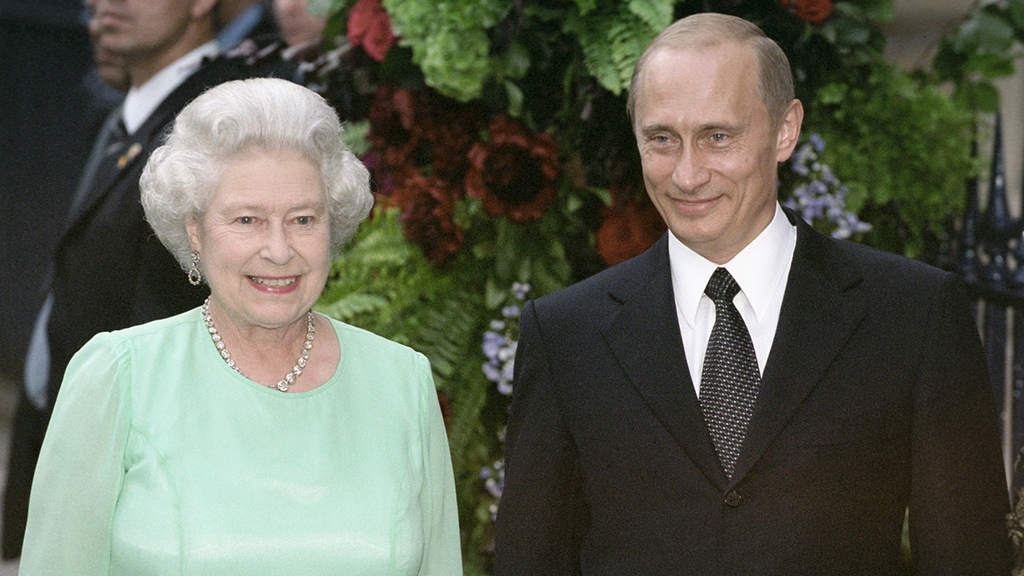
Meeting of Queens Elizabeth II and President Putin. Photo: Sergey Guneev/Sputnik
Russians have surprisingly tender feelings for Elizabeth, and on the day of the queen’s death, articles appeared in the official media that called the queen “the last living titan of the 20th century” and “the grandmother of all Britain.” And this is understandable: 70 years of reign were a guarantee of permanence: the world was changing rapidly, but the British had reliable support — Queen Elizabeth.
We hope that the visit of the British monarch (already new) to Russia will someday be repeated and the seeds of friendship presented to Yeltsin will sprout with new shoots and turn into a mighty tree of friendship that future generations of British and Russians will be able to admire.
Cover photo: V. Sneerson/ITAR-TASS
Mikhail Reznikovych: “Even now, in wartime, people visit the theatre”
Virginia Woolf and her fascination with Russian literature
Flower etiquette in the UK: how to thank artists
Related Articles
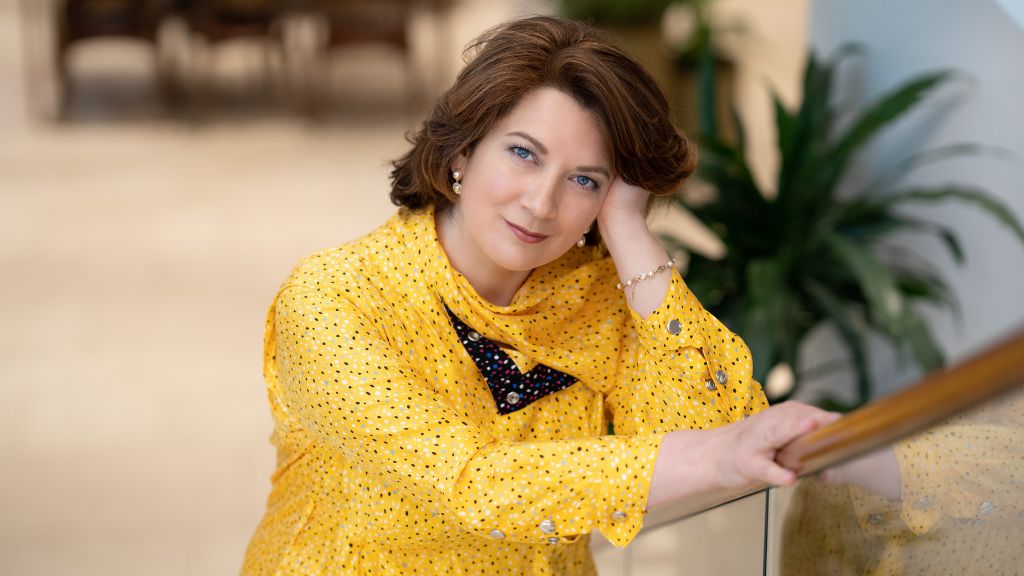
Receive our digest once a week with quality Russian events and articles

Who was Boris Yeltsin and who plays him in The Crown?
Yeltsin's visit to the UK and The Queen's visit to Moscow in 1994 are both dramatised in the new season of The Crown.

- James Hibbs
- Share on facebook
- Share on twitter
- Share on pinterest
- Share on reddit
- Email to a friend
Amidst all the internal family politics on display in The Crown season 5, there are also episodes which stray outside of the royal disputes to focus on other historical events.
One of these is Ipatiev House, the sixth episode of the season which deals further with Prince Philip's friendship with Penny Knatchbull , but also with Russian leader Boris Yeltsin.
Yeltsin's visit to the UK, and The Queen's visit to Moscow in 1994 are both explored, but just who was Yeltsin and who plays him in The Crown?
Read on for everything you need to know.
Who was Boris Yeltsin?

Boris Yeltsin was a Russian politician, who between the years of 1991 and 1999 acted as the first president of the Russian Federation, following the collapse of the Soviet Union. He followed Mikhail Gorbachev, who was the last leader of the Soviet Union up until its dissolution, and his leadership was succeeded by Vladimir Putin.
More like this
Yeltsin had previously been a member of the Communist Party, but quit the party in July 1990, before becoming the first popularly elected leader in Russia's history.
He served two terms as President, during which time he oversaw the country's transition to a capitalist economy, and visited London in 1994. Later that same year, Queen Elizabeth II became the first British monarch to visit Russia since the 1917 revolution.
Yeltsin died in 2007 aged 76.
Who plays Boris Yeltsin in The Crown?

Yeltsin is played in The Crown by Belarusian actor Anatoliy Kotenyov .
Kotenyov is known for appearing in films such as As Far as My Feet Will Carry Me, Dezha vyu and Chetvyortaya planeta. He also recently appeared in series such as Street Justice and Kris+Tina.
How does Boris Yeltsin factor into The Crown season 5?

Boris Yeltsin appears in The Crown season 5 episode 6, called Ipatiev House. At the start of the episode, Jonny Lee Miller's Prime Minister John Major returns from a visit to Moscow and says that the people there love Yeltsin, but that he's not sure he was ever once sober when they were in one another's company.
He told Imelda Staunton's Queen that Yeltsin is an anglophile who would love to receive an invitation to the palace. However, while The Queen initially seems to have a positive impression of this idea, her Private Secretary then informs her that when he was younger Yeltsin had been a regional official in the city where Ipatiev House was located - where the Romanov family were executed in 1918.
Yeltsin visits the palace and during lunch invites The Queen to visit Moscow to celebrate the end of Communist rule. However, The Queen tells him he should have considered what happened at Ipatiev House, understanding that he personally gave the order for the house to be destroyed. She says she considers this an act of great disrespect to her family's memory.
Yeltsin says the orders came from the very top and that he will do everything he can to restore the Romanovs' dignity, to which she says they can then discuss a royal visit.
During official photographs, Yeltsin says in Russian to those with him that The Queen shouldn't lecture him, and that the Romanovs' fates were actually sealed in Buckingham Palace.
Be the first to get the latest drama news, direct to your inbox
Keep up to date with all the dramas - from period to crime to comedy
By entering your details, you are agreeing to our terms and conditions and privacy policy . You can unsubscribe at any time.
The Queen later visits Moscow after the Romanovs' bodies are uncovered, but a last minute hold-up occurs when they're unable to identify two of them. A funeral can therefore not take place as was planned.
In private, The Queen admits to Philip how disappointed she is that her relatives will not yet be buried, after they had travelled there specifically to see that happen.
Later, back in the UK, John Major confirms that the bodies have been identified and the burial can take place, explaining that Yeltsin was "positively giddy" that a line could finally be drawn under the matter.
The Crown seasons 1-5 are available on Netflix now. Sign up for Netflix from £6.99 a month . Netflix is also available on Sky Glass and Virgin Media Stream .
Looking for something else to watch? Check out our TV Guide or Streaming Guide .
The latest issue of Radio Times magazine is on sale now – subscribe now and get the next 12 issues for only £1. or more from the biggest stars in TV, listen to the Radio Times View From My Sofa podcast .

Subscribe to Radio Times
Try 10 issues for just £10!

Looking for cheap travel insurance?
Compare quotes today from over 35 providers with Quotezone

Could equity release help you?
Get the retirement you deserve. Read the guide written by Paul Lewis and find out if equity release could help you
The best TV and entertainment news in your inbox
Sign up to receive our newsletter!
- Newsletters
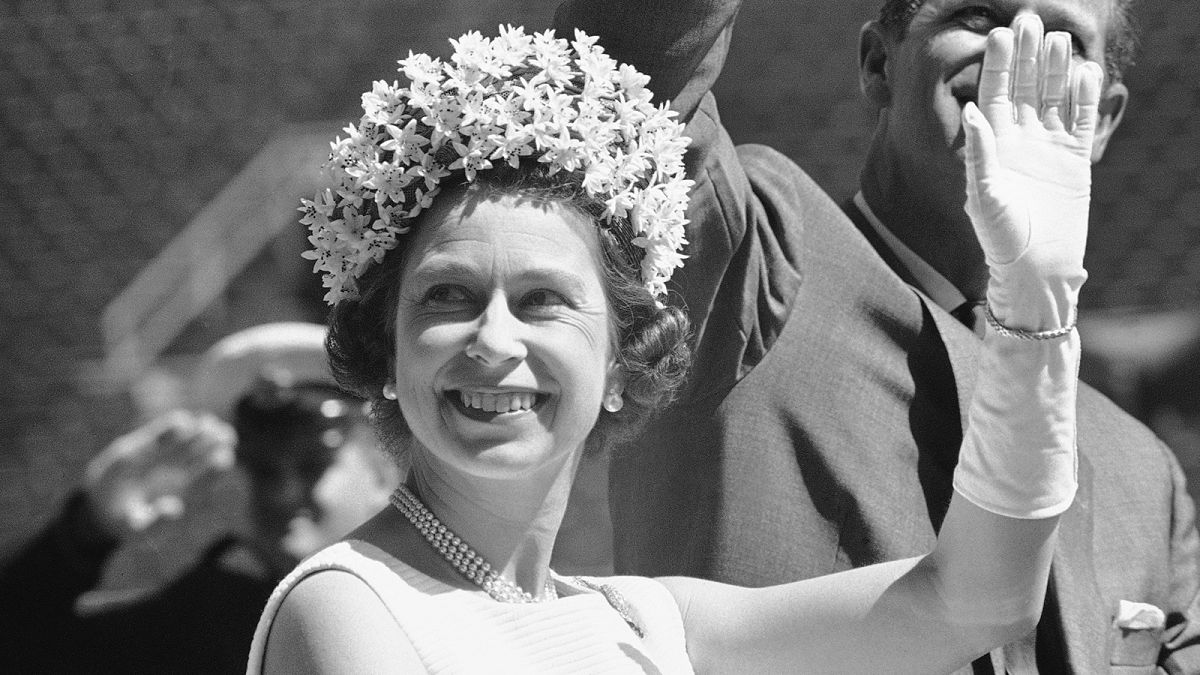
From Churchill to Yeltsin and Tito to Trudeau, the Queen's extraordinary reign in pictures
Domestically, she saw 15 UK prime ministers take office. Abroad, she met 13 out of the last 14 US presidents. Here are some of the most important moments during the Queen's record-breaking reign.
Queen Elizabeth II's death on Thursday marks an end to her record-breaking seven decades on the throne, with only France’s Louis XIV ahead of her in the history books.
During her reign, she saw 15 British prime ministers come and go, from Winston Churchill to Liz Truss, via the likes of Margaret Thatcher and Tony Blair.
The monarch also met 13 of the last 14 US presidents, a total of 10 French leaders and seven popes.
Ruling over the Commonwealth, it was Canada that she visited most often — 22 times.
The Queen also set foot in 117 countries and was the first reigning UK monarch to visit Ireland and Russia, among others.
But more importantly, she witnessed the UK and the world change many times over, with more than 100 countries gaining independence in her lifetime.
We look back at some of the most important moments in the life of the beloved British monarch.
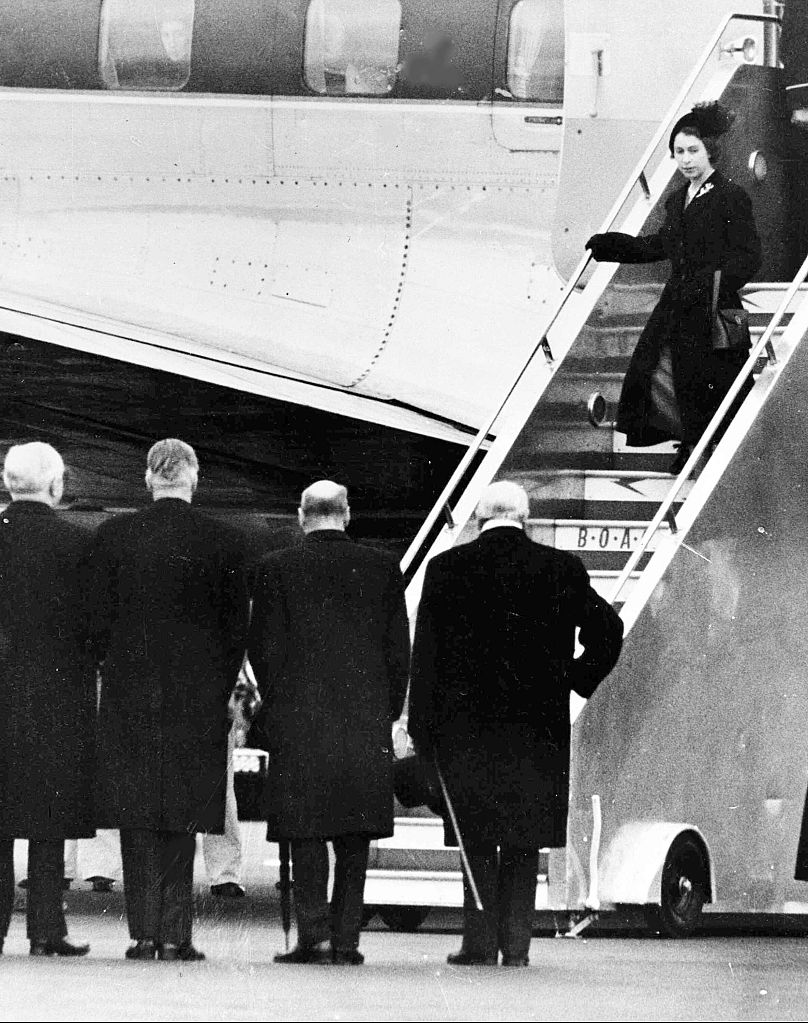
Elizabeth famously took the throne in 1952 at the age of 25 upon the death of her father, King George VI.
Cutting her trip to Kenya short, she is seen here as she stepped down from her plane in London, for the first time as sovereign, on 7 February.
Churchill was the first to greet her, together with opposition leader Clement Atlee and other members of the cabinet.
The hero of five wars and a World War II icon, Churchill was infatuated with the young royal, having known her since her birth as a close friend of her father, and the two remained close throughout Churchill's mandate as he believed Elizabeth II embodied all of the hallmark qualities a British sovereign should have to lead the country forward into a new, post-war era.
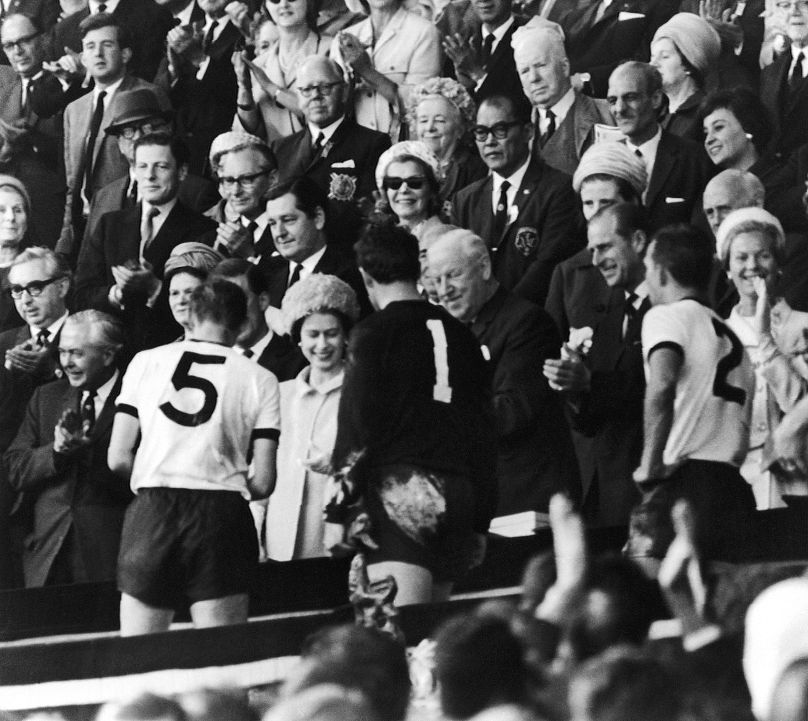
Despite her being politically non-partisan, it is widely believed that the Queen maintained the most relaxed relations with Labour Party's Harold Wilson, who served as the country's PM in two periods -- between 1964-1970 and 1974-1976.
The leftist leader, who came from a politically active middle-class family, was known for his everyman appeal and quirky, amiable personality.
Wilson also stood out from his more high-class predecessors due to the distinct Yorkshire accent and being only 10 years older than the Queen -- and the friendship the two struck was best illustrated by Elizabeth II inviting Wilson to stay over for drinks and allowing him to smoke his pipe during the weekly meetings she kept with all of her PMs during her reign.
In return, Wilson carried her photo in his wallet and spoke highly of the Queen until his death in 1995.
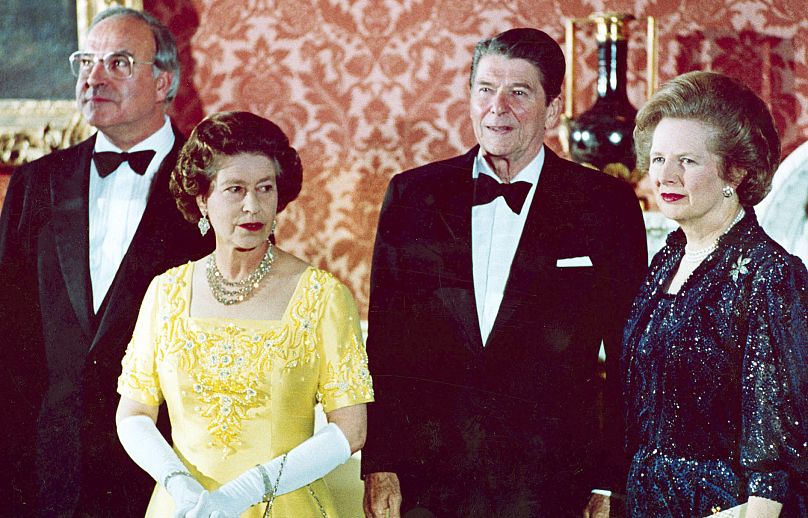
When "Iron Lady" Margaret Thatcher took office, few believed that she would remain PM for 11 years. The European country was suddenly headed by two powerful women, who did not always see eye to eye.
The differences between the two hinged on their characters: the Queen was famous for her dry wit, while Thatcher did not have a pronounced sense of humour, leading to their meetings being formal and cordial throughout Thatcher's time as prime minister.
Yet Elizabeth II -- who actively served in World War II -- seemed to have had a soft spot for Thatcher, who was just six months her senior and disapproved of the way the Conservative Party disposed of her in 1990.
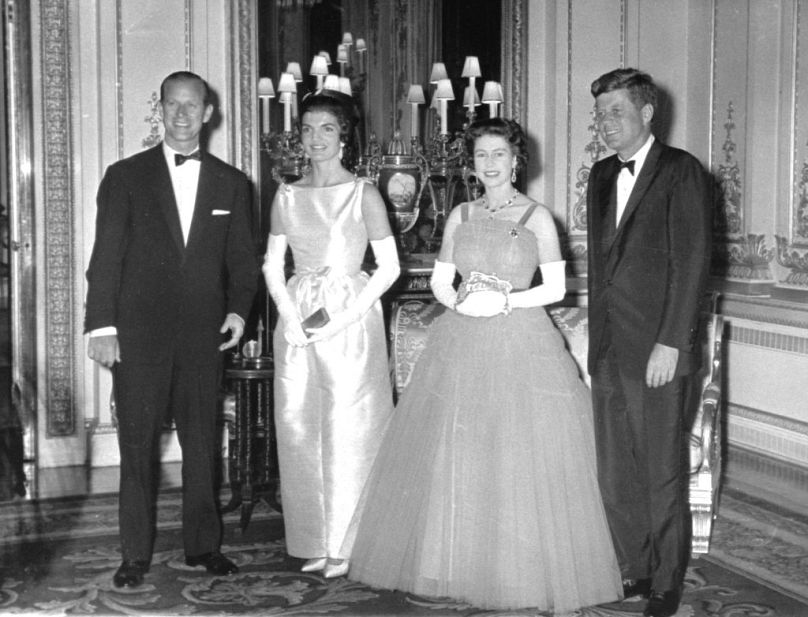
While the entire world was taken by the charm of US President John F Kennedy and his wife, Jackie Kennedy, the Queen was said to have been not too impressed, mainly due to the criticism both JFK and Jackie had after their 1961 visit to Buckingham Palace.
The presidential couple were not impressed by the palace, and Jackie was believed to have gone as far as to offend her majesty, stating she was "pretty heavy going", according to Gore Vidal.
Yet there is no actual evidence that this ever reached Elizabeth II. Inaugurating a UK memorial for JFK two years after his assassination in 1963, the Queen only had the kindest of words for the late US president.
“The unprecedented intensity of that wave of grief, mixed with something akin to despair, which swept over our people at the news of President Kennedy’s assassination, was a measure of the extent to which we recognised what he had already accomplished and of the high hopes that rode with him in a future that was not to be,” she said at the time.
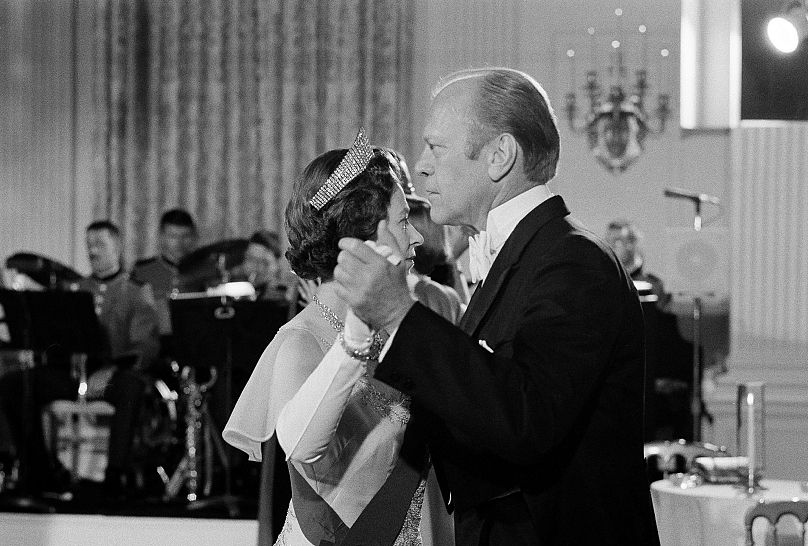
Having met 13 out of the last 14 US presidents, the Queen was known for having the closest relations with Dwight Eisenhower and Ronald Reagan -- two distinctly different US leaders, both in terms of their political leanings and their background.
Her first state visit to Washington came in 1957, hosted by President Dwight D. Eisenhower, at an important moment for the new sovereign to represent her country with its most important ally.
Eisenhower, the commander of US forces in Europe during World War II, hosted Elizabeth II during her first state visit in 1957, striking up a long-standing friendship that would see Ike, as he was known, visit the Queen in Balmoral, her estate in the Scottish Highlands where she died on Thursday.
Her promise to give him her recipe for scones turned into them becoming pen pals, with the two exchanging letters even after Eisenhower left the office in 1961.
Reagan -- who made a name for himself as a Hollywood actor, mostly appearing in Westerns before becoming president -- also did not hide his sympathies for the Queen, with their friendship revolving around their mutual love of horses.
After visiting Windsor in 1982, Reagan returned the favour by hosting the Queen at his Rancho Del Cielo property in California, serving her a Tex-Mex meal of enchiladas and tacos.
Their close relations also continued after Reagan's presidency ended, while she also awarded him with an honorary knighthood for his country's involvement in the Falkland Wars.
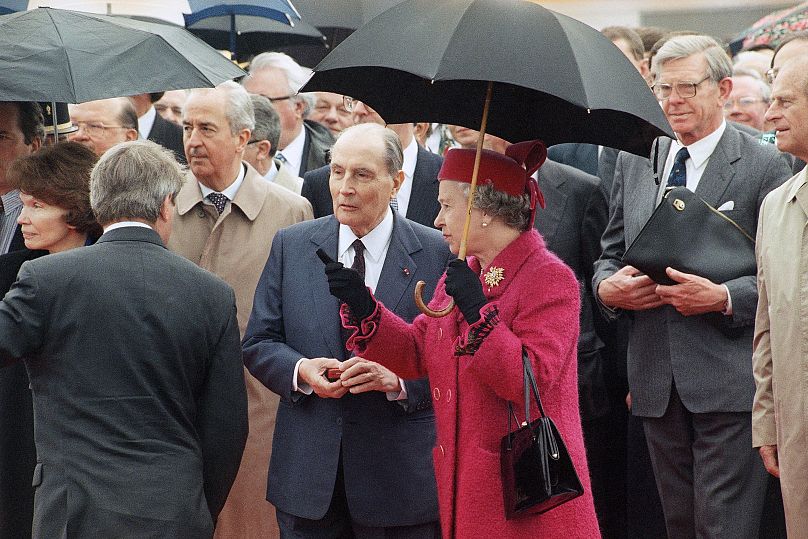
Known for being a Francophile, Elizabeth II had already captured the hearts of the French by the time she was 22, visiting the country instead of her father in 1948.
The first socialist head of state Vincent Auriol awarded her with the Legion of Honour, to which she responded with a speech in impeccable French.
The Queen also famously saved Charles de Gaulle's wife Yvonne of embarrassment caused by her limited knowledge of the English language during the couple's visit to London in 1960, but it was her friendship with François Mitterrand that stood out the most.
The two met on a number of occasions between 1981 and 1995 -- notably at the inauguration of the European Union in 1992 and at the opening of the Channel Tunnel in 1994.
When Elizabeth II last saw Mitterand, she was aware that he was becoming increasingly ill and that it was most likely the final time they would meet. Those present at the meeting said that she practically ran to greet him in a rare show of affection that struck everyone.
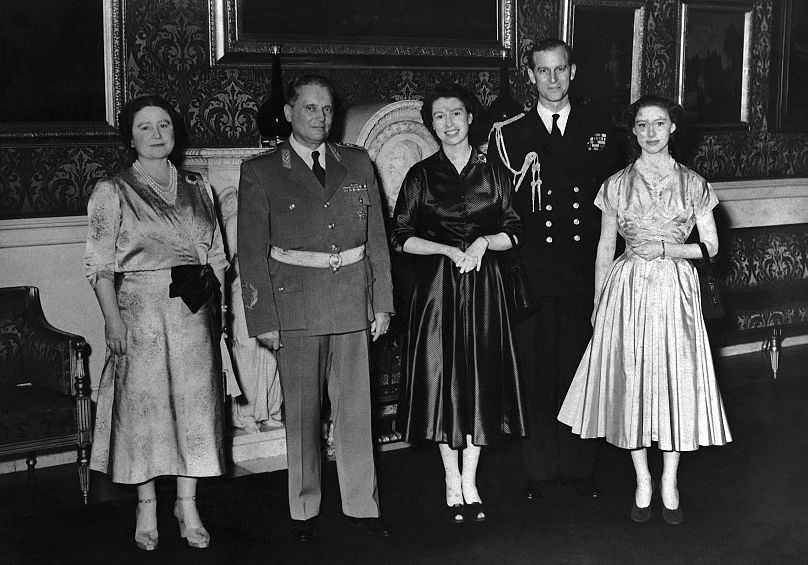
After emerging victorious from World War II together with the rest of the Allies, the onset of the Cold War meant that the UK saw its relations with the communist bloc escalate to the point of constant fears of potential nuclear conflict.
However, the Queen did not hesitate to invite the wartime anti-fascist leader of Yugoslavia, Josip Broz Tito, to an official visit to Buckingham Palace as early as 1953.
Just five years prior, the Yugoslav president -- a friend and ally of Churchill -- severed his ties with Joseph Stalin and the Soviet Union and found himself in between two blocs, eventually organising a third, Non-Aligned Movement and keeping the country mostly open to Western influence.
Elizabeth II returned the favour in 1972, with her trip to Belgrade marking the first visit of a UK sovereign to a communist country.
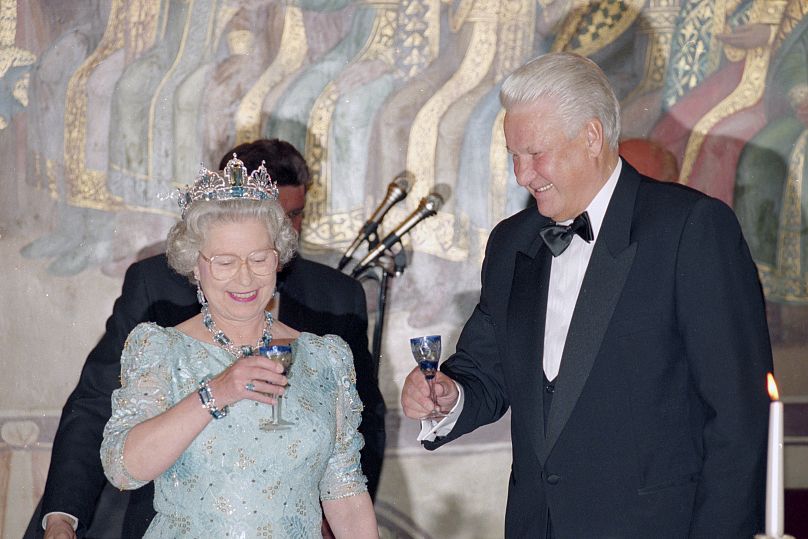
Yet it took another 22 years for her to set foot on Russian soil, another first for a reigning British monarch.
With the Cold War over, following the fall of the Berlin Wall in 1989 and the breakup of the Soviet Union three years later, Elizabeth II embarked on a trip to Moscow hosted by Russian President Boris Yeltsin.
The October 1994 visit was highlighted by what was a very warm welcome by Yeltsin, who had a Rolls-Royce drive the Queen from the airport to the Kremlin and organised a lavish banquet for the British royal, clinking glasses to the renewed UK-Russian relations.
Elizabeth II, in fact, was of Russian descent, having been the great-niece of the Russian Emperor Nicholas II, while her husband Philip also had family ties with the Romanovs. One of the reasons for the Queen's long-standing refusal to visit the USSR was due to the execution of the Russian royal family following the Bolshevik revolution.
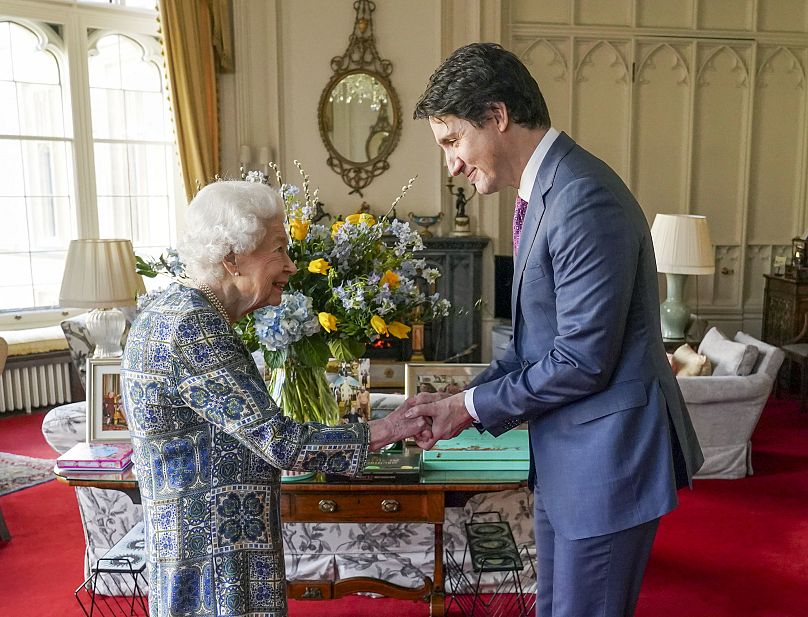
Ruling over 14 countries of the Commonwealth, Elizabeth II has long maintained close relations with Canada's leaders, having visited the country on 22 occasions during her seven decades on the throne -- more than any other state in the world -- including father and son Pierre and Justin Trudeau.
Although her relationship with Pierre was often cited as tense, with him being openly critical of "vestiges of colonialism" and acting aloof in Queen's presence, his son had an openly warm relationship with Elizabeth II.
The two first met in 1977 when Justin was just five years old, having arrived with his father at a G7 meeting in London. Finding out about her death, Justin Trudeau said, “as her twelfth Canadian prime minister, I’m having trouble believing that my last sitdown with her was my last”.
"She was one of my favourite people in the world," he told reporters in Vancouver.
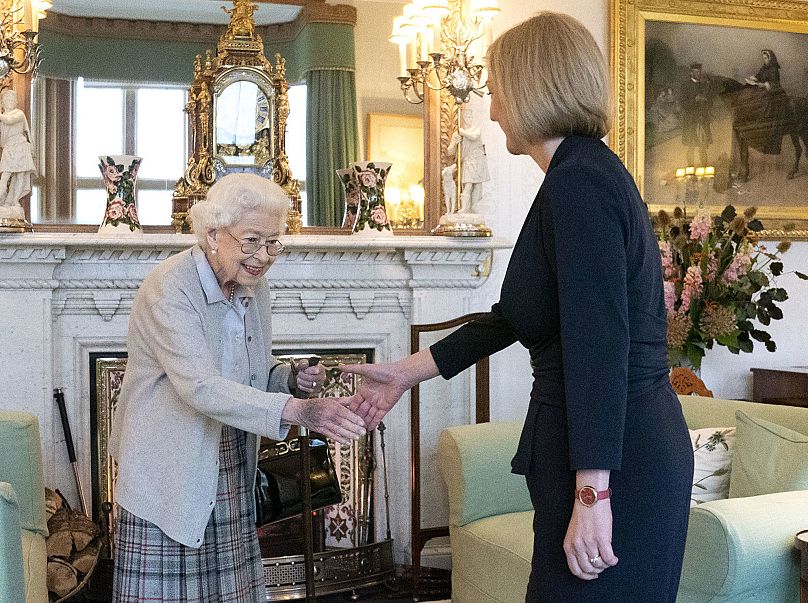
On Tuesday -- just two days before her death -- the Queen met Liz Truss, the last prime minister and politician she would receive over her long reign.
Truss, as well as her predecessor Boris Johnson, were both born after the Queen became the British sovereign.
With King Charles III becoming the UK's new monarch on Thursday and Truss being appointed prime minister just two days earlier, this week is very much the start of a new chapter for the country.
You might also like
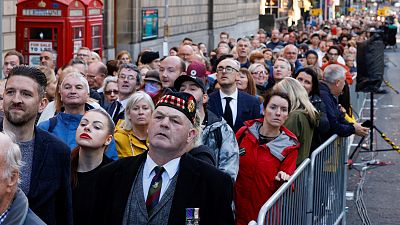
Thousands line up overnight to pay respects to Queen in Edinburgh
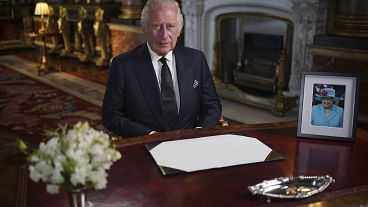
The next steps for the new King Charles III
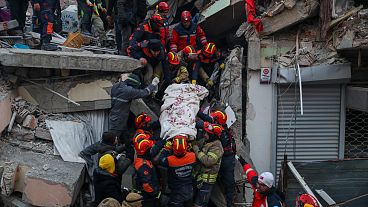
In pictures: Two weeks after Turkey-Syria earthquake
The Queen's Jubilee — 65 Years and 11 Russian Leaders

Britain's longest reigning monarch Queen Elizabeth II celebrates a reign spanning 65 years on Monday. When she became head of state, Joseph Stalin was leader of the Soviet Union. Her six-decade tenure on the throne has seen 11 Soviet and Russian leaders come and go.
As the Queen celebrates her Sapphire Jubilee, The Moscow Times brings you an illustrated history of her meetings with Soviet and Russian leaders throughout the this century and the last.
More image galleries
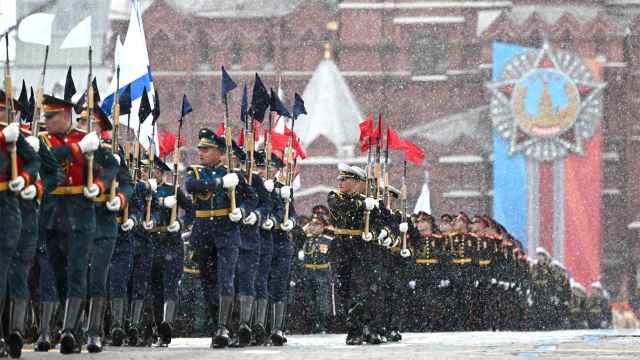
In Photos: Moscow Holds Third Victory Day Parade Since Ukraine Invasion
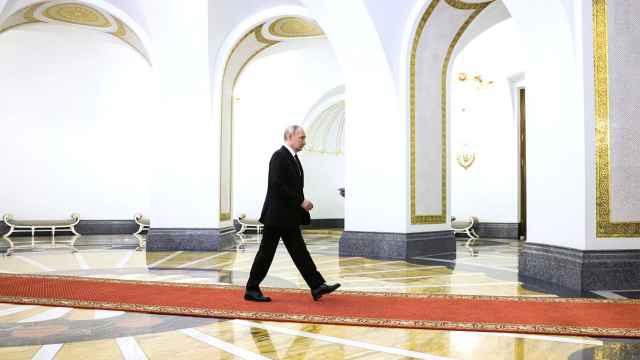
In Photos: Putin Inaugurated as President for Fifth Term
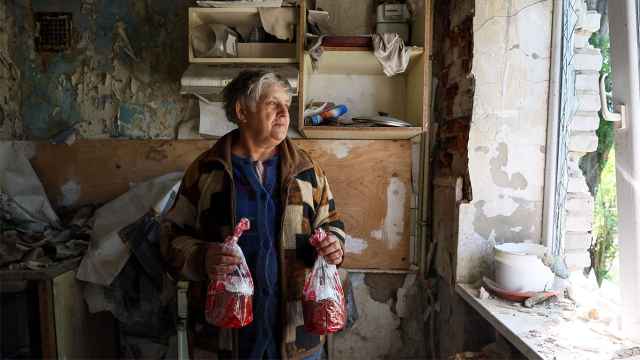
In Photos: Russia Celebrates Another Wartime Easter
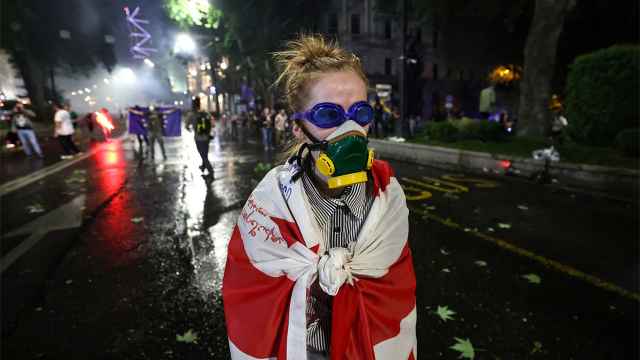
In Photos: Georgian Riot Police Clash With Protesters Rallying Against 'Foreign Influence' Bill
User validation

The Crown S5 E6 real history: the Romanovs’ murder, and Philip’s “spiritual companionship”
Episode six, ‘Ipatiev House’, brings decades-old global tensions to the surface once more, with the Queen grappling with the gruesome fate of her Romanov relatives as current-day relations with Moscow start to thaw. Elsewhere, Prince Philip admits his need for “companionship”, outside of the Queen…

- Rhiannon Davies
- Share on facebook
- Share on twitter
- Share on whatsapp
- Email to a friend
Episode six begins by transporting us back to 1917, when Britain was still in the grip of the First World War . A government official interrupts a cosy royal breakfast, passing King George V (played by Richard Dillane) an official letter from No 10 Downing Street. Scanning it, he asks his son, Edward (Adam Buchanan) to pass it to his wife, Queen Mary (Candida Benson), as “her judgement is unfailingly better than mine”.
The royals were debating whether to send aid to their beleaguered Russian relatives, the Romanovs, who were being held by the radical Bolsheviks. In the drama, Prime Minister David Lloyd George promised to send a ship to rescue them – if George agreed to it.
- Read more | The last days of the Romanovs: could George V have saved the family?
But agreement was not forthcoming, and in the following scenes the Romanovs are butchered by the Bolsheviks. Kept prisoner in the crumbling Ipatiev House in Yekaterinburg, they are herded into the house’s basement – under the guise of taking photographs before being moved to safety – when Russian soldiers flood in and open fire.

The Crown ’s brutal depiction of events is sadly very close to reality. On the evening of 16 July 1918, the Romanovs were coerced down into the basement, lined up against the wall and, in the early hours of 17 July, were massacred. In an article for HistoryExtra , historian Helen Rappaport describes the family’s fate: “Professional marksmen would have completed their gruesome task in seconds, but it took a 20-minute frenzy of shooting, screaming, acrid smoke and fumes, blood and gore before ferocious bayonetting finally finished off those victims still alive”.
Read more about the history behind each episode of The Crown season 5:
- The Crown S5 E1: ‘Queen Victoria Syndrome’ and a second honeymoon
- The Crown S5 E2: Prince Philip’s ‘keeper of secrets’ and Andrew Norton’s book on Princess Diana
- The Crown S5 E3: exiled royals and the al-Fayeds
- The Crown S5 E4: the Queen’s “annus horribilis” and Princess Margaret’s relationship with Peter Townsend
Were George V and Mary responsible for the Romanovs’ deaths?
Rapaport also considers the idea that the British royals were responsible for the tragic events – although tellingly, she says it’s commonly claimed that George had the power to save them, rather than Mary, as The Crown suggests.

More like this

She reveals the situation was far more complex than George simply being able to click his fingers and rescue the Romanovs. These events transpired in the midst of world war, and Russia was wracked by two revolutions in 1917. In the face of these developments, Rapaport argues “the Allied governments’ primary concern was keeping a demoralised and exhausted Russia in the First World War. Getting the former imperial family out of Russia to safety came a very poor second.”
Later in the episode, back in the 1990s, the Queen (Imelda Staunton) and Penny Knatchbull (Natascha McElhone) debate what could have motivated Mary to refuse to send aid to Russia. Whereas Penny claims Mary was jealous of the “prettier, grander” Tsarina Alexandra and didn’t want her to “upstage” her in Britain, the Queen argues: “Giving asylum to the Romanovs presented a much greater threat. There was widespread opposition to the tsarina in England, as she was seen as pro-German at the very time we were at war with them.”
The theory the Queen shares in the show might well be rooted in historical fact. Rappaport writes: “George V worried that to bring the controversial tsar and tsaritsa to England might cause unrest among the working classes sympathetic to the new revolutionary regime in Russia.” Moreover, she says, Alexandra was German, and “hostility towards Germany was at an all-time high, so much so that the British royal family changed its name from Saxe-Coburg-Gotha to Windsor that July”.
Sign up to receive our royal newsletter
Enter your email address now to receive news, features, podcasts and more
By entering your details, you are agreeing to our terms and conditions and privacy policy . You can unsubscribe at any time.
What happened during the Queen’s first state visit to Moscow?
Back in the 1990s, controversies surrounding the Romanovs’ demise are stirred up in The Crown , during Russian president Boris Yeltsin’s (Anatoly Kotenev) lunch at Buckingham Palace. When asked if she would come to Moscow on a state visit, the Queen makes it clear that the Romanovs’ fate – and Yeltsin’s own involvement in the story, as a minor official who ordered Ipatiev House should be demolished in the 1970s – is a major sticking point. The Queen also seems aware of Yeltsin’s reputation as a heavy drinker .

The Crown does show some bumps in their relationship – notably when Yeltsin says in front of the Queen, in Russian: “She [the Queen] should be careful, or she will end up with a bayonet up her arse too,” which historian Sarah Gristwood calls “pretty damned unlikely”. But later in the episode the Queen and Philip do travel to Moscow for a state visit.
Such a visit did take place, in 1994. According to The Guardian , “the visit to Moscow put an end to more than seven decades of estrangement between the Kremlin and Europe’s royalty”. Yeltsin was suitably aware of the magnitude of the moment, planning a lavish trip that featured a trip to the Bolshoi ballet.
The Queen also discussed the visit in her Christmas speech that year , proclaiming: “I never thought it would be possible in my lifetime to join with the Patriarch of Moscow and his congregation in a service in that wonderful cathedral in the heart of the Moscow Kremlin.”
Did Prince Philip’s DNA help identify the Romanovs’ remains?
Another key plot point of the episode is Philip’s involvement in positively identifying the Romanovs’ remains. After acid-damaged bones are unearthed in the forests close to Ipatiev House, experts turn to DNA testing to confirm that they belonged to the Romanovs. And Philip, being the tsarina’s great-nephew, helps the process by providing a blood sample, later revealing the match was “98.5 per cent” certain.
Although it might sound far-fetched, the Duke of Edinburgh actually did offer up some of his DNA to help scientifically determine whether the bones belonged to the Romanovs. As reported by the BBC in 1998 , Philip gave a DNA sample, and the remains of the tsar’s brother, Georgy, was also disinterred as part of the research effort.
Although the bones were confirmed to belong the Romanovs, arranging a burial for them proved difficult. As well as the Orthodox Church refusing to acknowledge that the bones did in fact belong to the Romanovs, various Russian cities competed for the honour of being the Romanovs’ final resting place. The burial finally went ahead in 1998, with Tsar Nicholas II, his wife and three of his children being laid to rest at the St Peter and Paul Cathedral in St Petersburg.
Was Prince Philip pursuing Penny Knatchbull?
Throughout the episode, there’s an undercurrent of tension in the royal marriage, which boils to the surface when the Queen and Philip are in Moscow. Sarah Gristwood told HistoryExtra : “[This conversation] is a big piece of psychodrama. The episode is set up on the premise that the relationship between Britain and Russia is a long marriage, in which there has been a blip – represented by communism and the Cold War. And the idea is that their marriage had a similar blip.”

This particular conversation in Moscow sees Philip rail against the Queen for the “atrocities” her relatives had historically unleashed upon his – with the British royals’ supposed link to the Romanovs’ deaths. Gristwood says: “I think that’s fiction rather than facts. We can’t know the conversations Prince Philip and the Queen had behind closed doors, and in the course of a marriage as long as theirs, there was bound to be moments of less than total agreement. But I do think that incident was very much set up for the purposes of drama.”
The conversation continues, with Philip eventually revealing his loneliness and that he’s “had to seek companionship elsewhere”. Although clarifying that this companionship is of an intellectual and spiritual nature, the Queen appears displeased when he reveals Penny Knatchbull is one person whom he has grown particularly close to.
- Read more | The Crown S5 E2 real history: Prince Philip’s ‘keeper of secrets’ and Andrew Norton’s book on Princess Diana
However, according to royal historian Tracy Borman, this doesn’t seem to match reality. She told HistoryExtra : “Neither is there anything to suggest that the Queen’s relationship with her husband grew more distant from the 1990s. In fact, the opposite seems to have been the case.
While Penny and Philip were close friends, attending carriage-riding competitions together, Tracy says “any hint of a more intimate relationship between them is purely speculative”. And of course, Elizabeth and Philip’s marriage continued well beyond the 1990s, with the pair remaining together until the Duke’s death in 2021.
- Read next | The Crown S5 E7 real history: the introduction of Martin Bashir, and a royal education

A former BBC History Magazine section editor, Rhiannon has long been fascinated by history and continues to write for HistoryExtra.com. She has appeared on the award-winning HistoryExtra podcast, interviewing experts on a variety of subjects, from Lucy Worsley discussing Agatha Christie to Sir Ranulph Fiennes on the perils of polar exploration

Receive a hardback and signed copy of a book of your choice when when you subscribe for £24.99 every 6 issues.
+ FREE HistoryExtra membership - worth £34.99!
Sign up for the weekly HistoryExtra newsletter
Sign up to receive our newsletter!

Subscriber today and get your Summer Read
+ FREE HistoryExtra membership & 15% Chalke History Tickets

USA Subscription offer!
Save 76% on the shop price when you subscribe today - Get 13 issues for just $45 + FREE access to HistoryExtra.com

HistoryExtra podcast
Listen to the latest episodes now
The Queen of travel
Queen Elizabeth II 1926 - 2022
Queen Elizabeth II leaves Fiji during a royal tour in February 1977. Serge Lemoine/Getty Images
The Queen of travel Journeys of a lifetime
By Francesca Street and Mark Oliver, CNN September 13, 2022
S he was traveling the moment she ascended to the throne, and for much of the next seven decades, Queen Elizabeth II criss-crossed the world. Newly married and still just a princess, Britain’s future monarch was in Kenya with husband Prince Philip in February 1952 when she learned of her father’s death and her new regal status.
During her reign she would visit more than 120 countries, witnessing first-hand the revolutions in global travel that shrank the world as her own influence over it diminished.
The Queen lived through the advent of the Jet Age, flew supersonic on the Concorde, saw regimes change, countries form and dissolve, the end of the British Empire and the rise of globalization.
Here are some of the most memorable travel moments from her 70 years as monarch.
November 24-25, 1953
Less than six months after she was crowned at Westminster Abbey in London, Queen Elizabeth set off on her travels again. Her debut official state trip was an epic six-month tour of the Commonwealth -- the alliance of nations which were once British colonies. Traveling by air, sea and land she visited several countries, accompanied by her husband, Prince Philip, the Duke of Edinburgh. First stop was the North Atlantic island of Bermuda, a British territory she would visit a further four times during her reign. The trip would go on to include stops in Jamaica, Tonga, New Zealand, Australia, Cocos Islands, Ceylon (now Sri Lanka), Aden (now part of Yemen), Uganda, Malta and Gibraltar.
December 19-20, 1953
At Queen Elizabeth’s coronation in June 1953, Queen Salote Tupou III of the Polynesian kingdom of Tonga won over the British public when she sat, rain-soaked, in her open carriage. They also took an interest when Elizabeth returned the visit later in the year. The two queens enjoyed an open-air feast, watched Tongan dancers and admired a tortoise that legend said was presented by explorer Captain James Cook to the King of Tonga in 1777.
December 23, 1953 – January 30, 1954
New zealand.
The Queen voyaged to New Zealand during the Antipodean summer of 1953-4. Over the course of the trip, it’s estimated that three out of every four New Zealanders got a glimpse of her. In preparation for the Queen’s visit, some New Zealand sheep were dyed in the UK flag colors of red, white and blue. The Queen returned to the country nine times over the years, including in 2002 as she marked half a century on the throne.
April 10-21, 1954
Ceylon (now sri lanka).
A visit to Ceylon, now Sri Lanka, coincided with the Queen’s 28th birthday. She visited the city of Colombo where crowds joined together to sing her “Happy Birthday.” She also visited the central city of Kandy, where she watched a procession featuring a reported 140 elephants and met local chiefs.
April 8-11, 1957
The Queen had visited France as a young princess, but her first state visit as monarch was a glamorous affair. She attended the Palais Garnier opera house in Paris, visited the Palace of Versailles, and dined at the Louvre with then-President Rene Coty. The Queen also laid a wreath on the Tomb of the Unknown Soldier at the Arc de Triomphe and visited the Scottish Church of Paris.
October 17-20, 1957
United states.
Having met President Harry S. Truman in Washington in 1951 during a visit before ascending to the throne, Elizabeth was no stranger to America when she arrived on her first trip as Queen. Her 1957 visit marked the 350th anniversary of the first permanent British settlement on the continent, in Jamestown. The monarch attended a college football game at the former Byrd Stadium in Maryland where she watched the home team lose to North Carolina. She met with President Dwight D. Eisenhower in the White House and later traveled to New York, where she and Prince Philip drove through the streets and admired panoramic views of the city from the Empire State Building.
February 1-16, 1961
The Queen and Prince Philip visited Pakistan in 1961, arriving in the port city of Karachi after completing a visit to India as part of a wider tour of South Asia. She drove through the streets of Karachi in an open-top car, before going on to visit Lahore, where a torchlight military tattoo took place in her honor and Prince Philip played in a game of polo.
February 26 to March 1, 1961
In Nepal, the Queen inspected troops in Kathmandu and met Gurkha ex-servicemen in Pokhara. The monarch rode on an elephant and visited the Hanuman Dhoka Palace complex in Kathmandu. She took part in the rather grim spectacle of a tiger hunt although didn’t shoot any animals herself. She instead recorded the experience on cine camera – a recording device that she often carried with her on her earlier foreign trips.
March 2-6, 1961
The Queen visited pre-revolution Iran at the end of her 1961 South Asian tour. Hosted by Shah Mohammad Reza Pahlavi, she toured ancient monuments including the ruins of Persepolis, once a capital of the Achaemenid Empire, later declared a World Heritage Site. She also saw Sheikh Lotfollah mosque in Esfahan and admired collections of the Archaeological Museum of Iran.
May 5, 1961
Vatican city.
In 1961, Elizabeth became the first British monarch to visit the Vatican. Dressed all in black, the Queen had an audience with Pope John XXIII, also attended by Prince Philip. She returned to the Vatican three more times during her reign, meeting Pope John Paul II and Pope Francis.
November 9-20, 1961
Bombing incidents in the capital Accra left officials worried about the safety of the Queen’s visit to Ghana but, after deliberation, UK Prime Minister Harold Macmillan confirmed it would go ahead. During the trip, the Queen famously shared a dance with Ghana’s then-president, Kwame Nkrumah. At the height of Cold War uncertainty, this seemingly innocuous moment was seen as significant in ensuring Ghana remained affiliated to Britain and not the USSR.
May 18-28, 1965
West germany (now germany).
The Queen’s visit to West Germany and West Berlin was viewed as a symbolic gesture of goodwill in the post-World War II landscape. It was the first royal trip to German territory for more than 50 years and photographs such as one of the Queen and Prince Philip in a car driving past the Brandenburg Gate had symbolic resonance.
November 5-11, 1968
Queen Elizabeth became the first reigning British monarch to visit South America when she landed in Brazil in late 1968. During the trip, the Queen wore a striking jewelry set made of Brazilian aquamarine, gifted to her in 1953 by the Brazilian president and added to over time. The monarch also attended a football match between Rio de Janeiro and Sao Paulo, and presented the winner’s trophy to Brazilian footballer Pele.
October 18-25, 1971
On the first of two trips to Turkey -- the second took place in 2008 -- the Queen visited the Gallipoli peninsula to remember the Allied soldiers who died there during World War I. The monarch also explored the ruins of the ancient Greek empire city of Ephesus. A media highlight of the visit came when she was photographed leaping ashore from a barge, after disembarking from her ship, the Royal Yacht Britannia.
February 10-15, 1972
Accompanied by Prince Philip and daughter Princess Anne, the Queen was greeted on arrival in Bangkok by a carpet of flower petals. The monarch was given a golden key to the city of Bangkok, attended a state banquet and visited Bang Pa-In Palace, the Thai royal family’s summer residence, north of the capital.
October 17-21, 1972
The Queen’s visit to Yugoslavia was her first trip to a communist country. The Central European country no longer exists -- the areas that the Queen visited are now part of Croatia. During her trip, she met Yugoslav political leader Josip Broz Tito and traveled on his famous Blue Train.
February 15-16, 1974
New hebrides (now vanuatu).
The Queen and Prince Philip visited the Pacific island archipelago of Vanuatu, then known as the New Hebrides, in 1974. It’s said the royal couple’s visit to Vanuatu may have strengthened the belief among some locals on Tanna island that the Duke of Edinburgh was a divine being.
February 24-March 1, 1975
On her first of two visits to Mexico, the Queen toured ancient sites -- including the pyramids of Uxmal, now a UNESCO World Heritage Site. The monarch also received local crafts, met school children and attended a banquet. While she was driven through Mexico City, the Queen was showered in confetti.
February 17-20, 1979
Saudi arabia.
In 1979, the Queen became the first female head of state to visit Saudi Arabia, on a tour of Gulf States. At Riyadh Airport, she was met by King Khalid bin Abdulaziz Al Saud, pictured. The outfits she wore on the trip were carefully designed in accordance with Saudi Arabia’s conservative dress code for women. The Queen arrived on a British Airways supersonic Concorde aircraft and during the visit attended camel races and toured the National Museum.
October 26-27, 1982
The Queen visited Tuvalu, a group of nine islands in the South Pacific, in 1982. Upon arrival, the Queen and Prince Philip were carried in a flower-filled canoe from sea to shore. Thirty years later, in 2012, Prince William visited Tuvalu with his wife, the Duchess of Cambridge, who drank a coconut from a tree planted by Queen Elizabeth on this 1982 visit.
February 26 – March 6, 1983
On a star-studded trip to the United States, the Queen toured the 20th Century-Fox studios in Hollywood with then-First Lady Nancy Reagan and met Frank Sinatra, who she’d previously met in the 1950s, at a party given in her honor. The Queen and Prince Philip also visited Yosemite National Park in California, pictured.
November 10-14, 1983
The Queen returned to Kenya in 1983 for a state visit. When she was there 31 years previously, she'd learned that her father had passed away and she had become Britain’s reigning monarch. In 1983, the Queen and Prince Philip revisited the Treetops hotel, pictured, where they were staying at the time she was told the news.
October 12-18, 1986
The Queen’s trip to China was the first -- and, so far, only -- state visit by a British monarch to China. With Prince Philip by her side, the Queen visited the Great Wall of China, pictured, as well as the Forbidden City in Beijing.
October 17-20, 1994
In 1994, in another royal first, the Queen visited Russia. Over the three-day trip, the Queen met Moscow mayor Yuri Luzhkov, pictured here with the monarch outside St Basil’s Cathedral, as well as Russian President Boris Yeltsin. The Queen also attended the Bolshoi Ballet. In her traditional Christmas Day speech broadcast later that year, the Queen reflected on how times had changed, noting she “never thought it would be possible in [her] lifetime” to attend a service in Moscow’s famous cathedral.
March 19-25, 1995
South africa.
In 1994, after apartheid ended, South Africa rejoined the Commonwealth as a republic. The following year, the Queen traveled there, in a visit designed to renew ties between the two countries. The Queen met with President Nelson Mandela, pictured, and presented him with the Order of Merit.
October 12-18, 1997
The Queen visited India for the third time in 1997, her first public engagement since Princess Diana’s funeral just weeks before. The trip marked 50 years since India’s independence from Britain. Most memorably, the monarch visited the site of the Amritsar massacre, also known as the Jallianwala Bagh massacre, of April 13, 1919. She also expressed regret at a state banquet in New Delhi for the “distressing” episode in which British soldiers gunned down hundreds of unarmed civilians. The gesture was seen by some as inadequate. “The Queen is doing everything she can to make India like her. But so far it does not seem to be working,” wrote the UK’s Independent newspaper at the time.
October 4-15, 2002
The Queen visited Canada many times. In 2002, her trip to the North American country coincided with her Golden Jubilee festivities, celebrating 50 years of her reign. During the trip, the Queen attended an ice hockey game between the Vancouver Canucks and the San Jose Sharks, and dropped the ceremonial puck.
March 11-16, 2006
The Queen visited Australia 16 times as Head of State. In 2006, she traveled to Melbourne to open the Commonwealth Games. She was greeted by a welcoming party in Canberra, visited the Sydney Opera House, attended a Commonwealth Day service in St. Andrew’s Cathedral and toured Admiralty House, the Sydney residence of the Governor-General of Australia.
May 17-20, 2011
The Queen’s trip to Dublin was the first time a British monarch had set foot in the Irish Republic since its 1922 independence. At Dublin Castle the Queen delivered a well-received speech on the history of Anglo-Irish relations. In County Tipperary, she also toured the medieval Rock of Cashel, pictured, once a seat of power for Ireland’s ancient kings.
November 26-28, 2015
From 1949 to 1951, before she was Queen, Elizabeth and Prince Philip lived in Malta. In 2015, the monarch paid her last visit to the island, touring the Grand Harbour in a Maltese fishing boat and waving to members of the British Royal Navy.
United Kingdom
In the later years of her reign, the Queen cut back on foreign travel, passing on the mantle to the younger royals. In more recent years, royal tours have also been looked at with more skeptical eyes, as Britain reckons with its colonial past.
While she didn't travel abroad in the later years of her reign, the Queen continued to vacation in the UK. Most notably, the Queen’s ties with Scotland remained strong throughout her reign and her residence there, Balmoral Castle, was a favorite refuge. It was at Balmoral that the Queen died on September 8, 2022.
See what Shop TODAY editors are loving! 23 Amazon finds to shop — from $6
- TODAY Plaza
- Share this —

- Watch Full Episodes
- Read With Jenna
- Inspirational
- Relationships
- TODAY Table
- Newsletters
- Start TODAY
- Shop TODAY Awards
- Citi Concert Series
- Listen All Day
Follow today
More Brands
- On The Show
'The Crown': What we know about the royal family's connection to the Romanovs
"The Crown" tells the story of the reign of the (now deceased) Queen Elizabeth II, who was on the throne from 1953 until just this past September.
But the story of the Windsors is more than the story of England, thanks to the intermarrying of royal families over the decades and centuries, it's also the story of Europe ... and, as we learn in Season Five, of Russia .
In Episode Six, a visit between the queen and then-Russian President Boris Yeltsin in 1994 serves as a springboard to flash back to the Russian Revolution of 1917, the execution of Tsar Nicholas II and his Romanov family, and to the DNA sample given in 1993 Prince Philip, the Duke of Edinburgh and the queen's husband, to help identify the unearthed remains of the Romanovs.
But how could this be? Students of history may be well-acquainted with the intermingling of the House of Windsor and the Romanovs, but maybe not everyone who watches "The Crown."
TODAY spoke with Russell E. Martin, professor of history at Westminster College in Pennsylvania, and author of " A Bride for the Tsar: Bride-Shows and Marriage Politics in Early Modern Russia ," to get the scoop about the links between the two dynasties.
Were King George V and Emperor Nicholas II related?
Short answer: Yes, they were first cousins.
George's mother Alexandra and Nicholas' mother Dagmar were daughters of King Christian IX of Denmark. Dagmar wed Russian Emperor Alexander III in 1866 and had Nicholas; Alexandra married Edward, Prince of Wales, who became Edward VII, in 1863, and had George.
George's royal house had actually been the House of Saxe-Coburg and Gotha, but after 1917 the name was changed to Windsor, when German names were not very popular among the British (see: World War I).
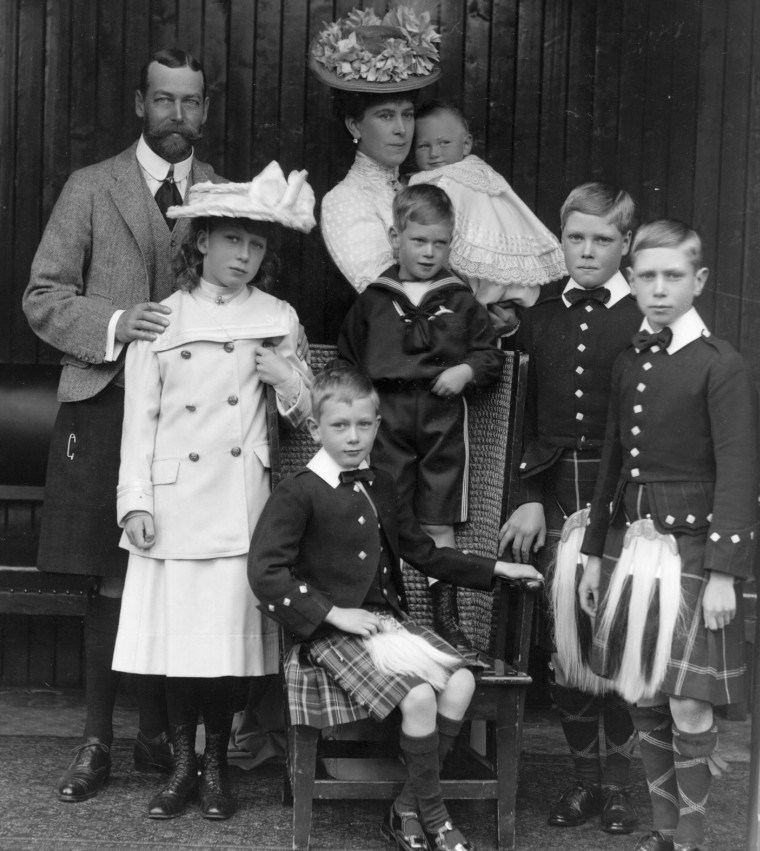
George V was Queen Victoria's grandson, and grandfather to the future Elizabeth II.
Notes Martin, "Christian IX is sometimes known as the 'Father-in-Law' of Europe,' because his children ruled or married into families that ruled in four European monarchies (Denmark, Greece, the UK and Russia)."
Did George and Nicholas know each other?
In fact they did, and frequently met, says Martin. When they were both young, there were regular vacations spent in Denmark, attended by Dagmar and Alexandra and their children, as well as other relatives. Meetings as adults included:
1893: While still Prince of Wales, the future George V wed Princess Mary of Teck and Nicholas (still the heir apparent, or Tsesarevich), attended.
1894: When Alexander III died (Nicholas' father and George V's uncle), George attended the funeral in St. Petersburg.
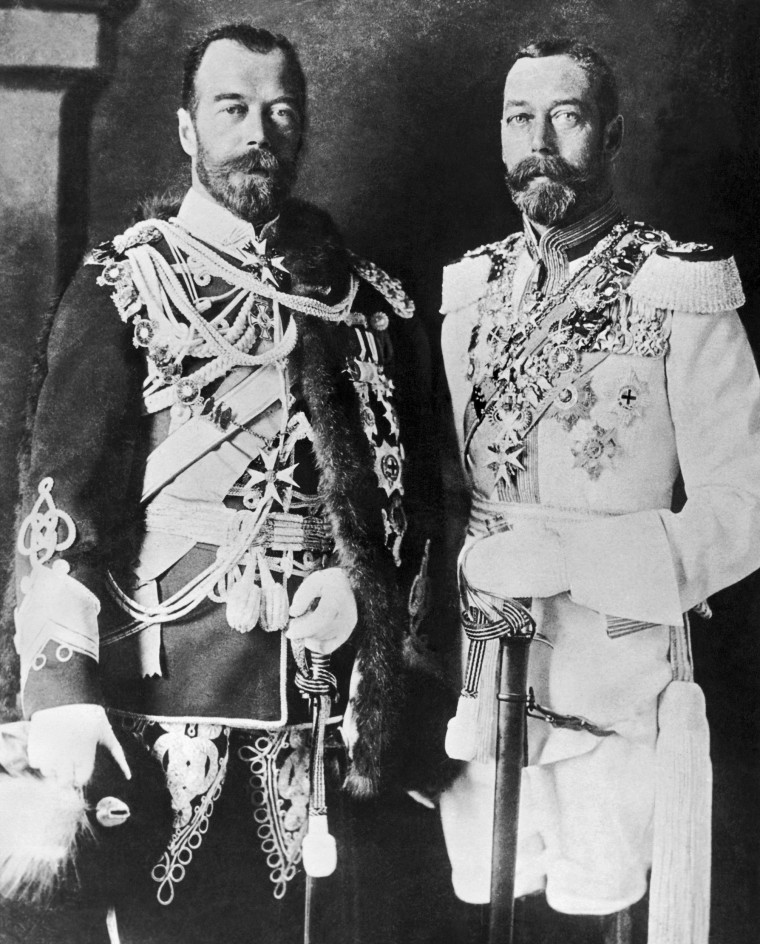
1909: The Romanov and Saxe-Coburg and Gotha families (the future Windsors) met up on the Isle of Wight for Regatta week and a naval review.
1913: On the eve of World War I, the cousins met in Germany for the wedding of the only daughter of their mutual cousin, the German Emperor (Kaiser Wilhelm II). There’s even a photo of them wearing German uniforms, since it was common for royalty to wear each other’s uniforms and orders and medals when on visits to each other, says Martin.
"They got on very well, personally," according to Martin. "The U.K. and Russia as nations had many points of potential conflict around the globe, and their overseas interests made them natural rivals. But George V very much liked Nicholas II as a man, and the feeling was mutual."
They looked a lot alike. Did people notice this at the time?
Photos of the pair of them together made the resemblance impossible to miss. There are at least two photos of the cousins together: One from George's wedding to Mary in 1893, and the 1913 picture of them in German uniforms, that attest to the strong resemblance.
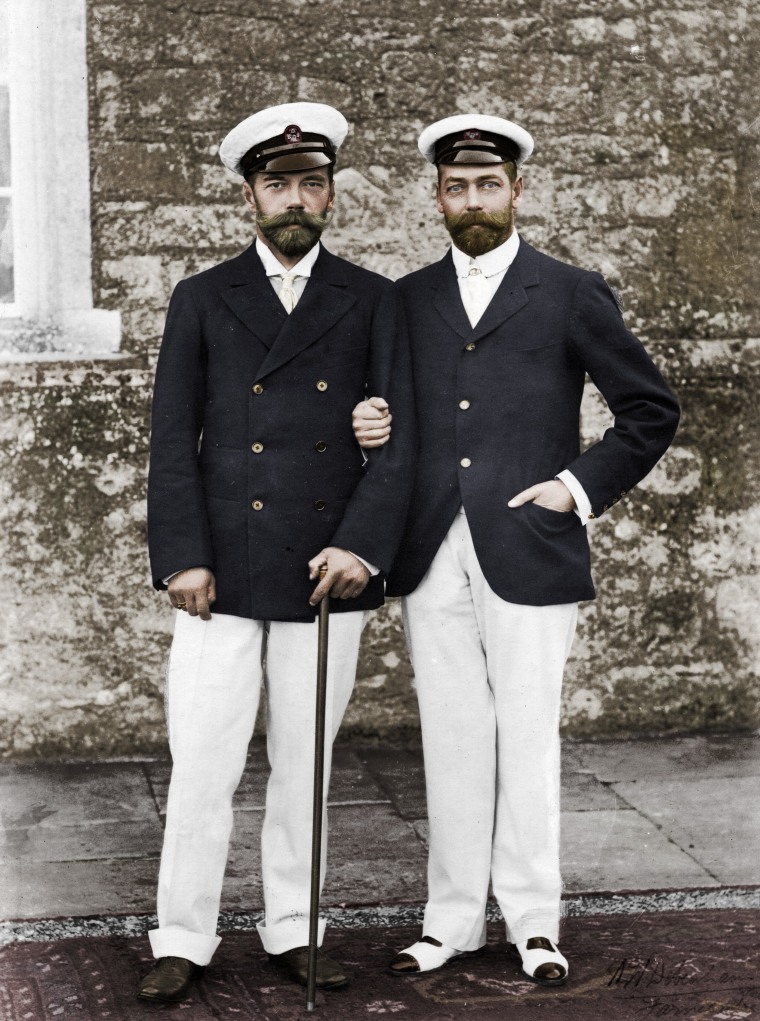
Additionally, said Martin, "There were several occasions during the wedding in 1893 where guests approached one or the other to chat only to discover that they were talking to the wrong man .... Most people attributed their resemblance to their Danish mothers."
During the Russian Revolution, did Nicholas ask for help from George? How did George respond?
The failure of the British government to extend asylum to the Romanovs was, for decades afterward, blamed on the then-Prime Minister Lloyd George. But when documents in the royal archives were opened to researchers, it turned out that George V was the one responsible for blocking asylum. Much of this information, said Martin, comes from the 1984 biography by Kenneth Rose, "King George V."
Lloyd George’s government was willing to grant asylum on humanitarian grounds and because of Russia’s alliance with Britain in the war, explains Martin, but the king feared the rising tide of worker unrest in Britain, the same kind of unrest he felt was responsible for toppling his cousin in Russia.
"George V very deeply and sincerely mourned the murders of Nicholas II and his family in July 1918," said Martin. "One can only wonder what sense of responsibility he may have privately felt when he received the news of the murders in Ekaterinburg."

The Russian Imperial Romanov family (which included Nicholas II, his wife Alexandra Feodorovna and their children Olga, Tatiana, Maria, Anastasia and Alexei) were imprisoned in Alexander Palace following the February Revolution, then transferred first to Tobolsk, then to Ekaterinburg in the Ural Mountains. In July 1918, the family was shot and bayoneted to death by revolutionaries, and the bodies were stripped, buried and mutilated with grenades so they couldn't be identified, then left in a mass grave in the Koptyaki forest.
Why was Prince Philip involved in identifying the Romanov remains?
Nicholas II's wife Alexandra and Prince Philip both descended from Princess Alice of Great Britain and Ireland , who was the daughter of Queen Victoria. Alexandra and Prince Philip were matrilineally descended, with all their family connections through women.
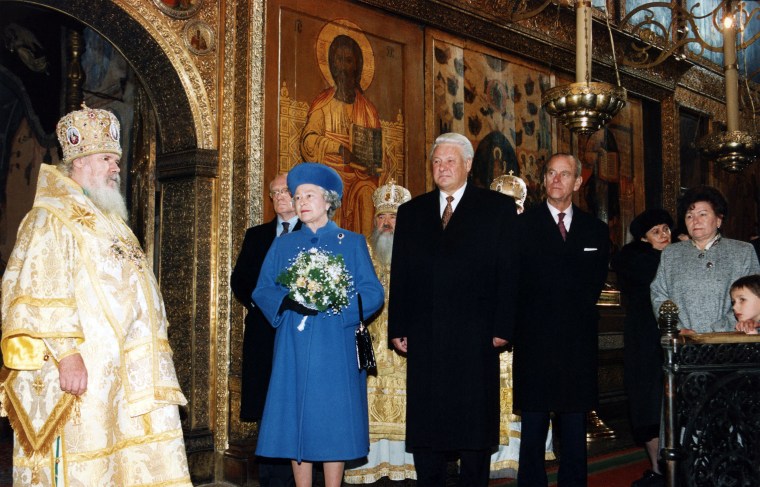
“That’s perfect for a comparison of mitochondrial DNA, which is transmitted to offspring exclusively from the mother,” said Martin.
Since the bodies of the Romanovs were left in a mass grave whose particular location was not well known, it took decades before they could first be found, and second identified. Both the Red Army and the Communist party refused to allow any investigation of the murders, so when a geologist found the grave in 1979, he kept it a secret until after the Soviet Union fell in 1991, explains Andrew Cook in " The Murder of the Romanovs ."
Nine skeletons were found buried in that grave, and over the years five of them were identified as the missing Romanovs: Nicholas, Alexandra and three of their four daughters. (The other four skeletons belonged to the servants of the Imperial Family who were executed along with them, per the investigation .)
Prince Philip's genetic connection to the Romanovs helped scientists make some of the early identifications. He gave a blood sample in 1993 that helped narrow things down.
"Prince Philip’s mitochondrial DNA was used to establish the identity of the bones of Alexandra and three of her children, which were discovered in 1991," said Martin. "The remains of Nicholas’s and Alexandra’s two other children (Alexei and one of the daughters), who were buried separately, were discovered in 2007 and were also conclusively identified using, in part, Prince Philip’s DNA sample."
Randee Dawn (she/her) is an entertainment journalist and author based in Brooklyn. In addition to writing for TODAY.com, Variety and The Los Angeles Times, her debut novel, Tune in Tomorrow , about a reality TV show run by mythic creatures, published in 2022. She's also the co-author of The Law & Order: SVU Unofficial Companion . When not interviewing the stars or dabbling in speculative fiction, she dreams of the next place she can travel to, or cuddles her Westie. More at RandeeDawn.com .
- Bahasa Indonesia
- Slovenščina
- Science & Tech
- Russian Kitchen
‘The Crown’ Season 5 on Netflix: Fact and fiction in the ‘Russian episode’
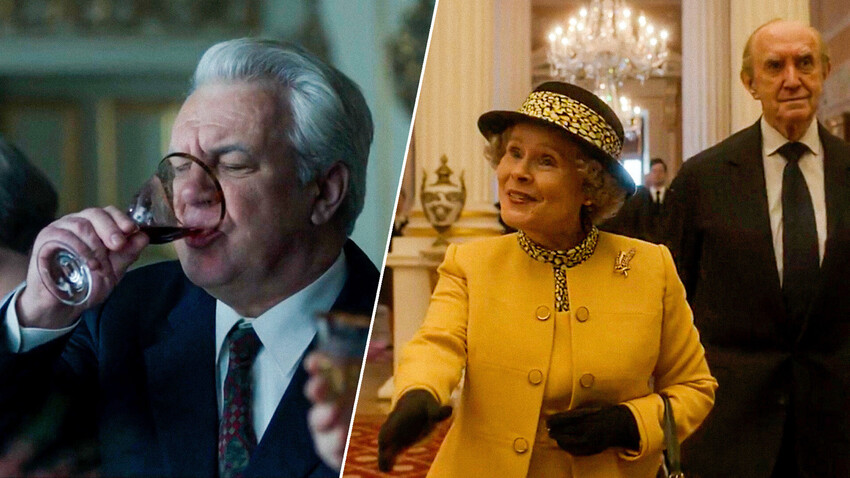
FACT: Blood ties between the Royal Family and the Romanovs
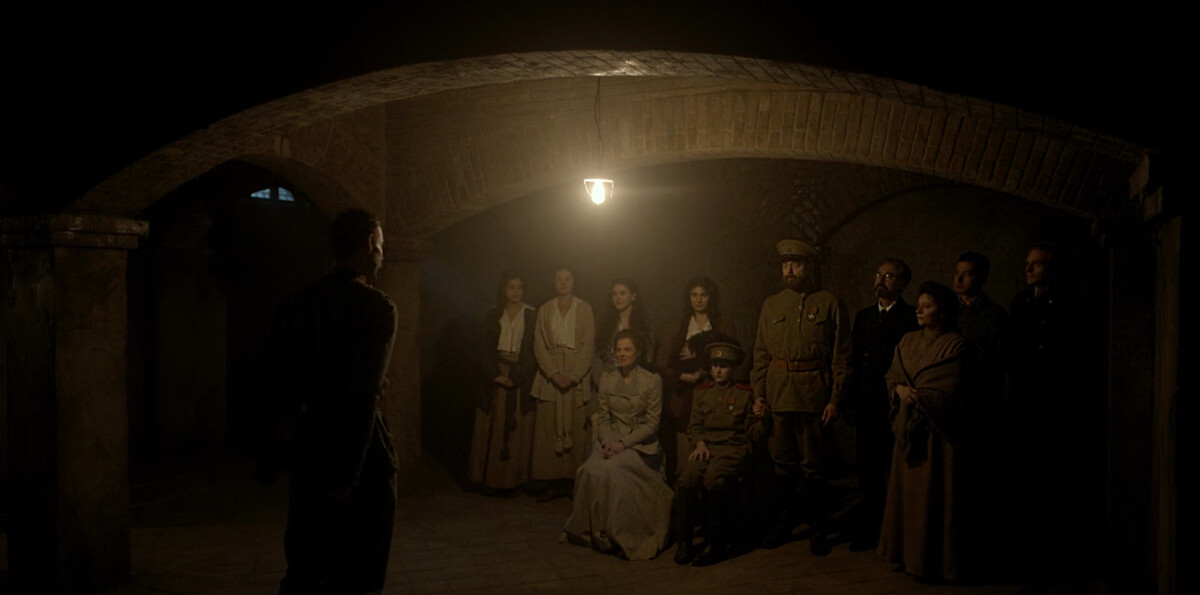
Episode 6 of ‘The Crown’ Season 5 begins with the execution of the Romanov family, a fate the Windsors could easily have saved their relatives from. Scenes from 1918, in which everyone speaks pretty good Russian, are intercut with the king out hunting. It was the king’s consort, Queen Mary, as not only the makers of the film but also some historians believe - who took the decision not to send a ship to rescue the Romanovs . Nicholas II and George V were first cousins and even looked alike. Consequently, Elizabeth II, the granddaughter of George V and particularly her consort, Prince Philip, great grandson of Nicholas I, were very wary about relations with Russia and regarded the Soviet authorities as “regicides”, which is why, during her entire reign, Elizabeth II never once visited the USSR.
FACT: The Queen’s state visit to Russia
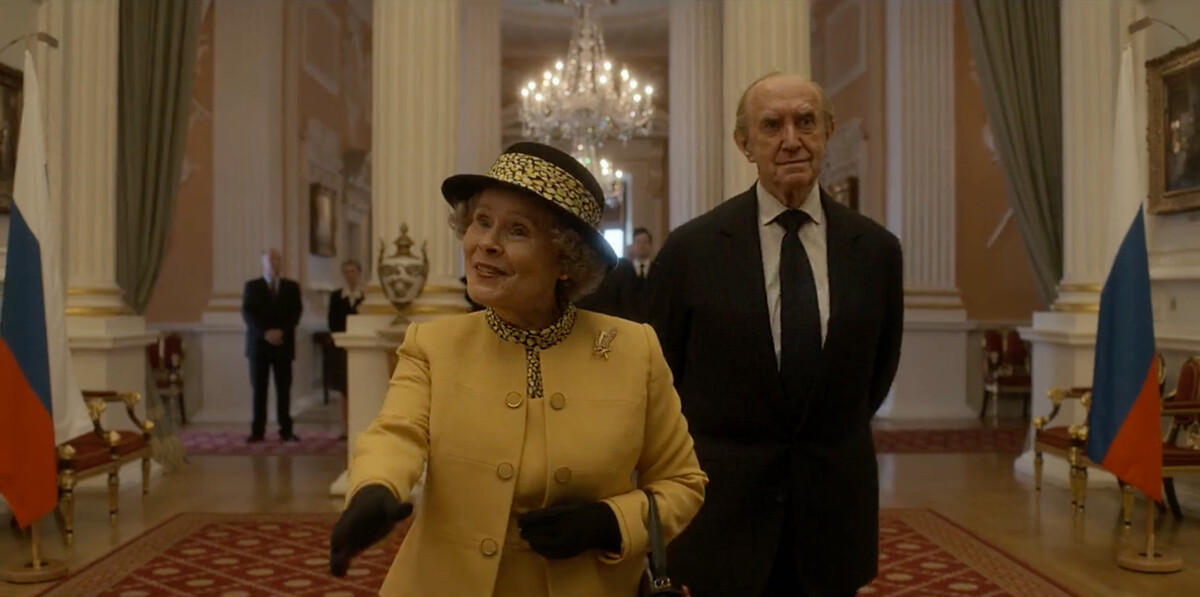
The latest season of ‘The Crown’ covers the first half of the 1990s, when the Soviet Union collapsed and democracy, ushered in by Boris Yeltsin, took the place of communism. It was after the collapse of the USSR and the emergence of an independent Russia that the queen paid her first visit to Moscow and St. Petersburg . It was a historic visit in every sense. She was the first British monarch to come to the Russian state. The queen’s program included all the main sights of Moscow and St. Petersburg, as well as the opening of a special museum dedicated to British history, but this was not included in the series.
FICTION: Reasons for visiting Russia
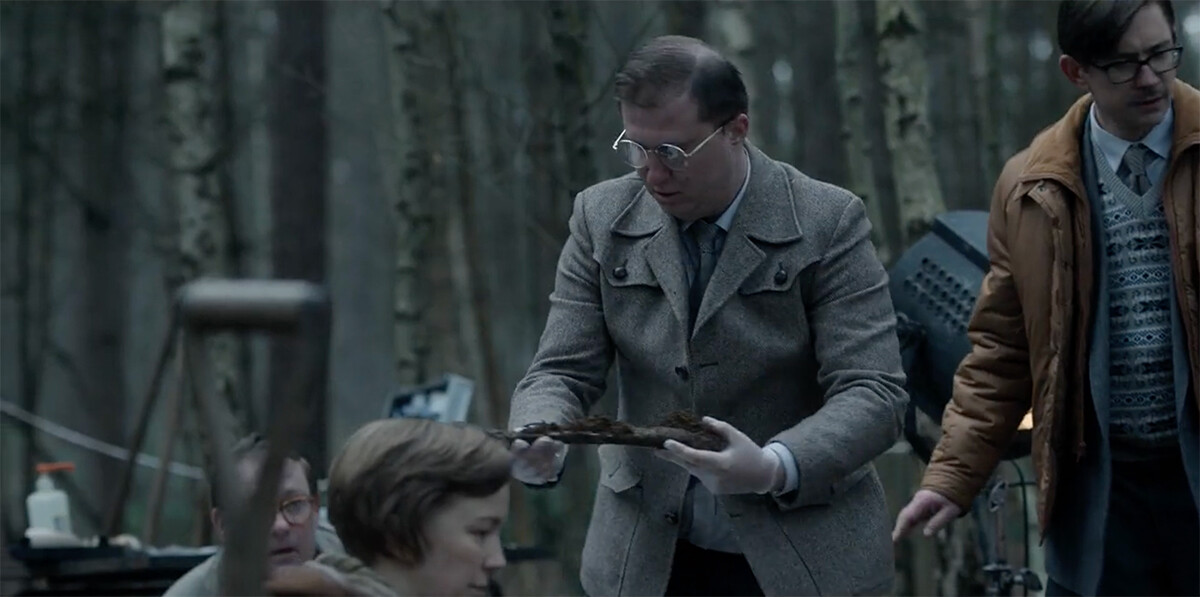
In ‘The Crown’, Elizabeth II visits Russia entirely for personal reasons - she wants to reconnect with her husband, Prince Philip, who, inspired by family links with the Romanovs, had become increasingly immersed in the Orthodox faith and his Slavic roots . According to the series, the Royal couple visit Moscow exclusively for the burial of their ancestors. Prince Philip’s DNA was indeed used for the scientific examination of the remains of the Romanovs, but this was more a consequence of, rather than the reason for, the Royal visit. The interment of the bones discovered in the Urals only took place in the late 1990s, although the forensic tests - involving both Russian and British experts - continued until the 2010s.
Read more: How did Tsar Nicholas II become a saint?
FICTION: A drunken Yeltsin on a tank, on a table and in Buckingham Palace
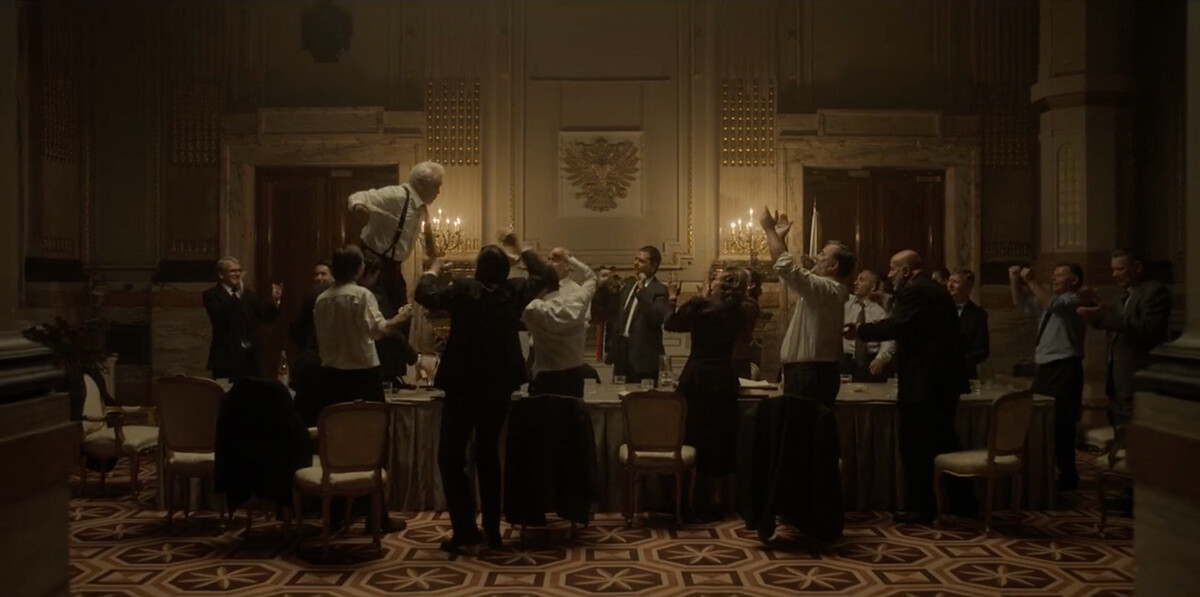
The chronology of ‘The Crown’ season 5 is its weakest element. For instance, Elizabeth’s wish to meet Boris Yeltsin (played by Belarusian actor Anatoliy Kotenyov), the leader of a newly-democratic Russia, arises almost immediately after she sees him on a tank near Moscow’s White House . At the same time, Prime Minister John Major tells the queen that the Russian president has long gone mad and has sunk into alcoholism, to the soundtrack of ‘Kalinka Malinka’, but this does not prevent the queen from receiving Yeltsin and his wife in her palace and then agreeing to a return visit to Moscow. In reality, Yeltsin never went to Buckingham Palace, although his meeting with Major did take place, while his alcohol problems did catch up with him a certain time after his audience with the queen.
FACT/FICTION: Tchaikovsky, Dostoevsky and the decline of the monarchy
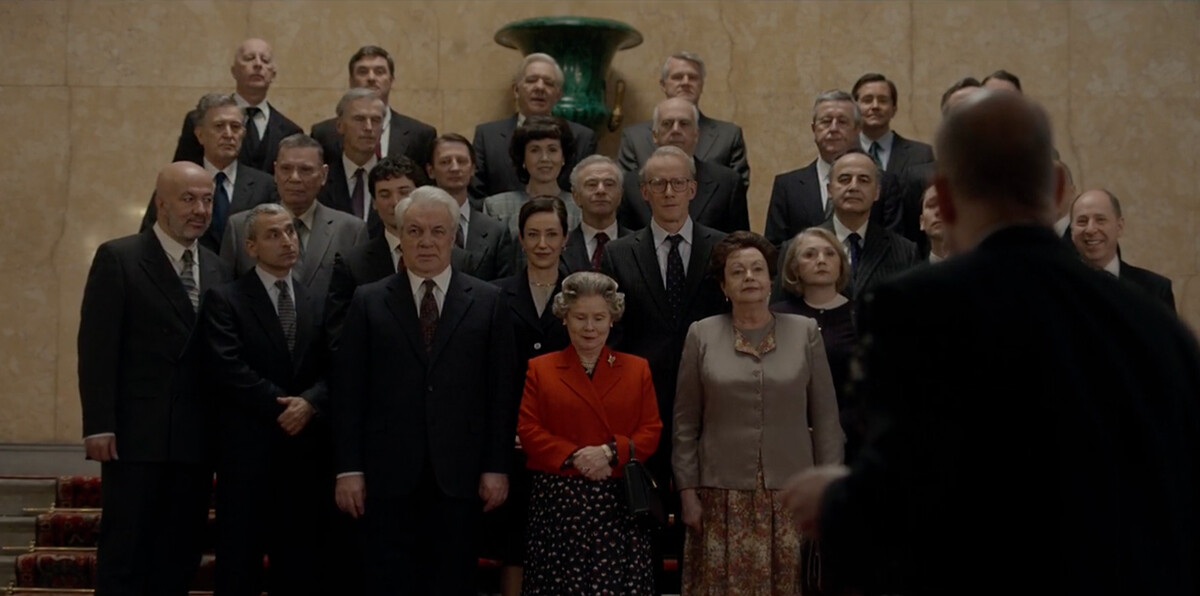
Season 5 of ‘The Crown’ has turned out to be the most intimate of all and the “Russian strand” has played no small part in this. In the very first episode, Prince Charles - the sole member of the Royal Family willing to take a fresh look at the monarchy - listens with interest to a radio report on the collapse of the Soviet Union, while Elizabeth’s ill-starred sister, Margaret, gets ready for a ball to the theme from Tchaikovsky’s ‘Swan Lake’. This foreshadows Diana’s meeting in the final episode with the Al-Fayed family, which is to play a baleful role in the subsequent season. “One of the most memorable accounts of a long, successful marriage comes from Dostoevsky’s wife, Anna. She and Fyodor were, she said, of… contrasting character. Different temperaments. Entirely opposing views, yet they never tried to change one another,” John Major tells the queen. It’s a pity that the House of Windsor took a different route.
Dear readers,
Our website and social media accounts are under threat of being restricted or banned, due to the current circumstances. So, to keep up with our latest content, simply do the following:
- Subscribe to our Telegram channel
- Subscribe to our weekly email newsletter
- Enable push notifications on our website
- Install a VPN service on your computer and/or phone to have access to our website, even if it is blocked in your country
If using any of Russia Beyond's content, partly or in full, always provide an active hyperlink to the original material.
to our newsletter!
Get the week's best stories straight to your inbox
- 10 important facts about the murder of Russia’s royal family
- Why did Britain’s King George V betray Russia’s last tsar?
- How the British royal family is related to the Romanovs
This website uses cookies. Click here to find out more.
- History Classics
- Your Profile
- Find History on Facebook (Opens in a new window)
- Find History on Twitter (Opens in a new window)
- Find History on YouTube (Opens in a new window)
- Find History on Instagram (Opens in a new window)
- Find History on TikTok (Opens in a new window)
- This Day In History
- History Podcasts
- History Vault
When a Russian President Ended Up Drunk and Disrobed Outside the White House
By: Becky Little
Updated: July 25, 2023 | Original: April 3, 2018

Bill Clinton and Boris Yeltsin had a weird relationship. There was the time the Russian president gave the U.S. president a pair of hockey jerseys that said “Yeltsin 96” and “Clinton 96.” There was also the time Clinton doubled over laughing when Yeltsin called the U.S. press “a disaster” at a press conference.
But perhaps the weirdest incident in their professional relationship was when Yeltsin got drunk and wandered into the street in his underwear, trying to get a pizza.
The incident happened during Yeltsin and Clinton’s first meeting in Washington in September 1994. Although there were glancing media reports about it over the years, it wasn’t widely reported on until 2009, when author Taylor Branch published his book The Clinton Tapes , based on his interviews with the president.
“Secret Service agents discovered Yeltsin alone on Pennsylvania Avenue, dead drunk, clad in his underwear, yelling for a taxi,” Branch wrote in his book. “Yeltsin slurred his words in a loud argument with the baffled agents. He did not want to go back into Blair House, where he was staying. He wanted a taxi to go out for pizza.”
When Branch asked Clinton how the situation ended, the president shrugged and said, “Well, he got his pizza.” But the next night, Clinton recalled, Yeltsin tried to do it again.
“Eluding security, he made his way down the back stairs into the Blair House basement, where a building guard mistook him for a drunken intruder,” Branch wrote. “Yeltsin was briefly endangered until converging Russian and American agents sorted out everyone’s affiliation.” Because the guards mistook him for an intruder, “Clinton thought this incident, although contained within Blair House, exposed even greater risk than the pizza quest.”

Unfortunately, these nighttime escapades illustrated a larger problem that Yeltsin had with alcohol. The Washington Post has reported that during the 1995 press conference where Yeltsin called the U.S. press “a disaster,” he was drunk on white wine. In another Post article, the former deputy secretary of state under Clinton suggested that the reason the U.S. president had laughed so hard at Yeltsin’s “disaster” jibe was because he was trying to cover for how drunk the Russian president was. Another time, Yeltsin reportedly called Clinton while inebriated and asked him to hold a secret meeting on a submarine.
During Yeltsin’s presidency from 1991 to 1999, his alcoholism worsened to the point where he was frequently stumbling and falling over. He also exhibited inappropriate behavior on camera, such as when he pinched a couple of female secretaries in front of reporters. These antics have now become a part of his legacy as a world leader.
Upon his death in 2007, the German newspaper Der Spiegel nodded to this fact with a notably blunt obituary title : “The Rise and Fall of the Drunken Czar.”

HISTORY Vault: U.S. Presidents
Stream U.S. Presidents documentaries and your favorite HISTORY series, commercial-free

Sign up for Inside History
Get HISTORY’s most fascinating stories delivered to your inbox three times a week.
By submitting your information, you agree to receive emails from HISTORY and A+E Networks. You can opt out at any time. You must be 16 years or older and a resident of the United States.
More details : Privacy Notice | Terms of Use | Contact Us
- Search Please fill out this field.
- Manage Your Subscription
- Give a Gift Subscription
- Newsletters
- Sweepstakes
Princess Elisabeth of Belgium, 22, is Moving to the U.S. — Find Out Why!
The future queen is following in her father's footsteps with the big decision
Janine Henni is a Royals Staff Writer for PEOPLE Digital, covering modern monarchies and the world's most famous families. Like Queen Elizabeth, she loves horses and a great tiara moment.
:max_bytes(150000):strip_icc():format(webp)/janine-henni-57d47b03f624493fb0e9843f319ac2c8.jpg)
MADS CLAUS RASMUSSEN/Ritzau Scanpix/AFP via Getty Images
Princess Elisabeth of Belgium has some exciting plans on the calendar — she’s moving to the U.S.!
On May 7, the Belgian Royal Palace announced that the 22-year-old heir to the throne is relocating stateside to enroll in a master’s program at Harvard University this summer.
"After having recently successfully completed the admission tests, Her Royal Highness Princess Elisabeth, Duchess of Brabant, will begin a master's degree in public policy this summer at Harvard University (Harvard Kennedy School) in Boston," the palace said in a statement , per a translation.
"This two-year course will complete her university education following her bachelor's degree in History and Politics at the University of Oxford (Lincoln College)," it continued. "The Princess was also selected for an ‘Honorary Award’ from the Fulbright program, the international exchange program in the field of education of the United States Department of State."
Belgian Royal Palace/ Instagram
The update from the court — including the prestigious Fulbright recognition — was shared along with one of Princess Elisabeth’s glam birthday portraits. The photos, released on the eve of her big day in October, showed her smiling in a navy tank with a high illusion neckline and sparkling embroidery.
The Harvard news comes as the Duchess of Brabant continues her education in preparation for a bright destiny ahead. As the firstborn child of King Philippe and Queen Mathilde , she follows her father in the line of succession and is poised to become Belgium's first queen regnant one day. King Philippe, 64, and Queen Mathilde, 51, are also parents to Prince Gabriel, 20, Prince Emmanuel, 18, and Princess Eléonore, 16.
Like many young modern heirs, Princess Elisabeth has focused on her education and occasionally dipped her toes into official duties by shadowing her parents. In March, she joined her dad at the Castle of Laeken to receive a special guest — former U.S. President Barack Obama .
The future queen previously earned her International Baccalaureate from the United World College of the Atlantic in Wales (a.k.a. Hippie Hogwarts , a popular choice for teens from several royal families) and trained at the Royal Military Academy in Brussels, where she took an officer’s oath in September 2023.
It's custom for those directly in the line of succession to train with their national military, and King Philippe did the same before his accession. His daughter’s U.S. move for school will also follow in his footsteps in another way, as the King studied at Stanford University in California for two years to earn a master’s degree in political science.
When officials announced that Princess Elisabeth would study at Oxford in England, it was emphasized that she would frequently travel back to her home country to stay connected.
Patrick van Katwijk/Getty Images
Can't get enough of PEOPLE's Royals coverage? Sign up for our free Royals newsletter to get the latest updates on Kate Middleton, Meghan Markle and more!
"The Princess will return to Belgium regularly and remain involved in Belgian public life," the statement said.
In December 2023, the young royal visited the Princess Elisabeth Children's Hospital in Ghent, spending time with patients and staff at the children’s hospital named in her honor. The stop was significant, as it marked her first solo visit to the medical center she inaugurated at age 9 in 2011, The Brussels Times reported.
Geert Vanden Wijngaert/Getty Images
Related Articles

IMAGES
VIDEO
COMMENTS
Queen Elizabeth II of the United Kingdom of Great Britain and Northern Ireland, her husband Prince Philip, Duke of Edinburgh and Foreign Secretary Douglas Hurd made a state visit to Russia from 17 to 20 October 1994, hosted by the President of Russia, Boris Yeltsin. It is the first and so far only visit by a reigning British monarch on Russian ...
In October 1994, president Boris Yeltsin hosted Queen Elizabeth and Prince Philip in Russia. It was the first—and only—time a reigning British monarch made a state visit to the country, and ...
(18 Oct 1994) Queen Elizabeth II took a tour of the Kremlin with President BorisYeltsin on Tuesday (18/10) and laid a wreath at a memorial toSoviet soldiers ...
In 1994 the Queen made a three-day visit to Russia. Three years before had seen the dissolution of the Soviet Union, when Yeltsin took office. ... Yeltsin's spokesman, Vyacheslav Kostikov, said at the time "We realize that the British queen would never have visited a Communist country." Read more. History of "God Save the King", Britain's ...
(18 Oct 1994) Queen Elizabeth II attended a black tie dinner at the Kremlin onTuesday (18/10) hosted by Russian President Boris Yeltsin. In herspeech the Que...
The Queen was hosted by Boris Yeltsin, the first president of Russia. At the time, a spokesman for Yeltsin noted the significance of the visit, saying: "We realize that the British queen would ...
Russian President Boris N. Yeltsin's chief spokesman, Vyacheslav V. Kostikov, said the queen's visit is evidence of Russia's break with its totalitarian past. Advertisement
Boris Yeltsin's visits to Britain and Ireland mixed high politics with low farce. The low point surely came on September 30 1994, when the then Irish prime minister Albert Reynolds, was left ...
October 17, 1994 at 8:00 p.m. EDT. MOSCOW, OCT. 17 -- Britain's Queen Elizabeth II arrived in Russia today for a visit that draws a symbolic close to seven decades of royal frostiness toward ...
Russia and the Queen. Once the communist regime collapsed, it was only a matter of time before a full resumption of relations with the royal family was possible. The Queen's first and only visit to Russia took place in 1994. Then President Yeltsin led the country.
Presentation of a book of the Six Decades of H.M.The Queen's Commonwealth and State Visits, 18 December 2012. Queen Elizabeth II undertook a number of state and official visits over her 70-year reign (1952 to 2022), as well as trips throughout the Commonwealth, making her the most widely travelled head of state in history.She did not require a British passport for travelling overseas, as all ...
Yeltsin's visit to the UK and The Queen's visit to Moscow in 1994 are both dramatised in the new season of The Crown. Wojtek Laski/Getty Images. James Hibbs; Published: Thursday, 10 November 2022 ...
MOSCOW, Oct. 17 -- Queen Elizabeth II arrived in Moscow Monday for a four-day visit that marks the first trip ever to Russia by a reigning British monarch. The queen was taken directly from the ...
The October 1994 visit was highlighted by what was a very warm welcome by Yeltsin, who had a Rolls-Royce drive the Queen from the airport to the Kremlin and organised a lavish banquet for the ...
Queen Elizabeth II visits Moscow's Red Square Oct. 17, 1994. ... Second left is the Russian Orthodox Patriarch Alexi II, with Russian President Boris Yeltsin behind the Queen.
809413. Max file size: 2731 x 4096 px (9.10 x 13.65 in) - 300 dpi - 5 MB. Boris Yeltsin. Elizabeth II. Buckingham Palace. 1990-1999. Arts Culture and Entertainment. British Royalty.
When asked if she would come to Moscow on a state visit, the Queen makes it clear that the Romanovs' fate - and Yeltsin's own involvement in the story, as a minor official who ordered Ipatiev House should be demolished in the 1970s - is a major sticking point. The Queen also seems aware of Yeltsin's reputation as a heavy drinker.
The Queen's visit to West Germany and West Berlin was viewed as a symbolic gesture of goodwill in the post-World War II landscape. ... as well as Russian President Boris Yeltsin. The Queen also ...
In Episode Six, a visit between the queen and then-Russian President Boris Yeltsin in 1994 serves as a springboard to flash back to the Russian Revolution of 1917, the execution of Tsar Nicholas ...
The chronology of 'The Crown' season 5 is its weakest element. For instance, Elizabeth's wish to meet Boris Yeltsin (played by Belarusian actor Anatoliy Kotenyov), the leader of a newly ...
Bill Clinton. "Secret Service agents discovered Yeltsin alone on Pennsylvania Avenue, dead drunk, clad in his underwear, yelling for a taxi," Branch wrote in his book. "Yeltsin slurred his ...
As the firstborn child of King Philippe and Queen Mathilde, she follows her father in the line of succession and is poised to become Belgium's first queen regnant one day. King Philippe, 64, and ...